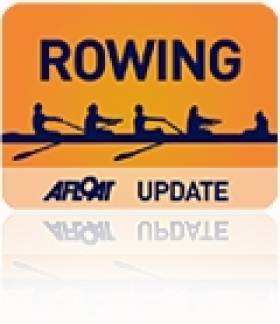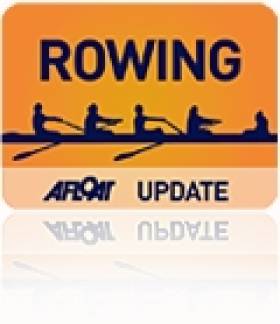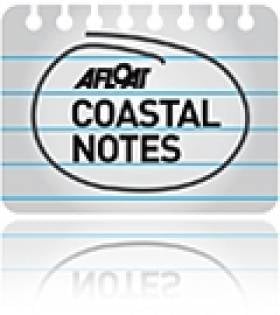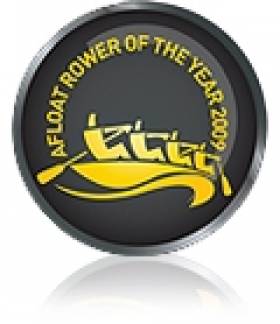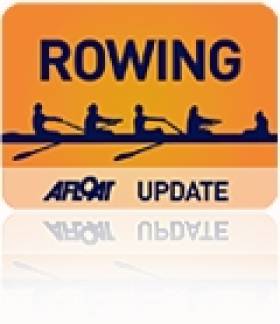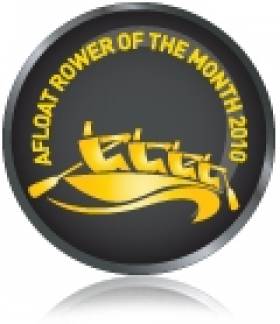Displaying items by tag: Nixon
2016 Irish Sailing Preview: Busy Year For Busy People Ahead
Things are on the move again. There’s a buzz in the air. W M Nixon anticipates the sailing possibilities for 2016 in a fixtures list so diverse that he reckons that anyone who thinks they know everything that’s going on clearly doesn’t.
If you want anything done, then ask a busy man to do it. And the busier people are ashore, the keener they are to get afloat when they can. There was nothing more sluggish than the sailing and boating scene during the recession years. There was less zest for going sailing when you’d all the time in the world to do it because there was nothing to do ashore. And anyway, as a vehicle sport, sailing was a very identifiable expense which could be reduced or even discarded as the recession rumbled on.
Of course, it wasn’t as simple as that. Anyone with businesses to run knew they’d to keep a very close eye on things all the time if they were to survive at all. Thus we became experts at the short sailing break. The four day regatta became all the rage, and even if the good times roll again as never before, it seems likely the four day regatta is going to stay popular.
It’s indicative of amazingly changed times. Today, it’s beyond imagination to realise that at the height of Scotland’s industrial pomp around Glasgow for eighty years into the 1960s, there used to be a Clyde Fortnight. Two whole weeks of sailing on the trot. Except for Sundays of course, when the church services became yachting events. But even with that spiritual input, it was conspicuous consumption gone mad to be able to show you’d the resources and free time to go off yacht racing for a clear fortnight, knowing your employees – or rather, your inherited company’s employees – would keep those profits and dividends rolling in while you swanned about on the bonnie waters of the Firth.
It took special stamina, too. But times and tastes have changed in any case. There are so many other sports, entertainments and interests vying for our attention these days that sailing has to keep re-inventing itself to make its mark. Yet beneath it all there’s still that elementally simple appeal so eloquently expressed by the folksy Floridian Clark Mills, who in 1947 created the Optimist dinghy:
“A boat, by God, it’s just a gleamin’ beautiful creation. And when you pull the sail up on a boat, you’ve got a little bit of really somethin’ God-given. Man, it goes bleetin’ off like a bird’s wing, you know, and there’s nothin’ else like it”.
It’s still as simple as that. So apart from the usual frostbite races and leagues, it’s more than appropriate that the first major sailing event in Ireland in 2016 is the legendary Optimist Training Week at Baltimore during the half term break in February. Yes folks, February. For sure, we know that in the old Irish calendar, February 1st is St Brigid’s Day, and officially the first day of Spring. But for many sailors, St Patrick’s Day on March 17th is about as early as we want to get. And for most of us, Easter is quite soon enough, thank you.

A harvest of Optys – Optimists racing at the Cork Dinghyfest 2015 in conditions rather different from those they’ll be expecting at Baltimore in February. Photo: Robert Bateman
Nevertheless we salute the keen Opty kids who in February drag their families along with them down to Baltimore – even unto the family dog – in a caravanserai which tells us much about Irish sailing. But what we also know is that Irish sailing is universal, and from times past we’re well aware that our new season is reckoned to start with the Rolex Sydney-Hobart Race on December 26th in the dying days of the old year. So the up-coming dash to Hobart is when our new year begins, and back in December 2012 when Gordon Maguire won it overall - his second overall win in this great Australian annual classic - he was undisputed Afloat.ie “Sailor of the Month” for January 2013.
As we’re on the cruiser-racer theme, we’ll stay with it for now through to the August fixtures, and anyone totally into dinghies and nothing else is invited to scroll down a dozen paragraphs to where we emerge from the world of truck-racing for a consideration of the Olympics, the inshore racing classes, and the dinghies.
But for now staying with cruiser-racers, in recent months Gordon Maguire has been making the Mediterranean scene with success aboard the Mark Mills-designed Max 72 Caol Ila (ex-Alegre), but as the Australian season currently swings back into top gear, he’s in the Matt Allen camp aboard the Carkeek 60 Ichi Ban. However, another Irish line of interest continues with Wicklow-based designer Mark Mills, whose newest 45ft footer Concubine – fresh built in Dubai – is going to an Adelaide owner who will have her at optimum trim for her first big outing in the Hobart race.
 Flying machine. The new Mark Mills-designed 45ft Concubine arrives in Australia on November 22nd
Flying machine. The new Mark Mills-designed 45ft Concubine arrives in Australia on November 22nd
Meanwhile, notwithstanding the Optimists gearing up for their February Sailfest in Baltimore, things at home really start on Friday February 4th when the Irish sailing focus closes in on the august yet friendly premises of the Royal College of Surgeons on Stephens Green in the heart of Dublin for the annual ISA/Afloat.ie National Sailing Awards. Sailors of the Month, Sailor of the Year, Mitsubishi Motors Club of the Year and many other well-earned awards will be swept through in a festival of mutual congratulation and camaraderie which perfectly captures the spirit of a sport which has a longer history in Ireland than anywhere else.
 Can they do it again? The Royal Cork Yacht Club – with Marine Minister Simon Coveney – at the ISA/Afloat.ie Sailing Awards 2014 ceremony in the RCSI in Dublin on Friday 6th March 2015, when they swept the board and took the Mitsubishi Motors “Club of the Year” award for good measure. The 2015 awards will be presented at the same venue on Friday, February 4th 2016.
Can they do it again? The Royal Cork Yacht Club – with Marine Minister Simon Coveney – at the ISA/Afloat.ie Sailing Awards 2014 ceremony in the RCSI in Dublin on Friday 6th March 2015, when they swept the board and took the Mitsubishi Motors “Club of the Year” award for good measure. The 2015 awards will be presented at the same venue on Friday, February 4th 2016.
University sailing also comes top of the bill in the Springtime, with the Irish championship seeing titleholders UCD defend a position which also saw them representing Ireland at the Student Yachting Worlds in France in October, when they placed third overall. It sounds reasonable enough, but Ireland has won the Worlds a couple of times in the recent past, so there’s work to be done here.
Another area where work is being done is in the growing interest for Under 25 Squads in doing great things with revitalised J/24s. Cillian Dickson of Howth led his Under 25 group to success both in J/24 and open racing in 2015 with the J/24 Kilcullen, and the word is that 2016 will see at least three similar teams making the scene at national and local events.
But for boats with a lid, the top item on the agenda has to be the fact that this is a biennial Commodores’ Cup year, and we’re the defenders. In 2014, thanks to the single-minded determination of Anthony O’Leary, a competitive three boat team was somehow assembled from some very disparate parts, and the title - won in 2010 but undefended in 2012 in the depths of the recession - was re-taken in very positive style after a week of ferocious racing in late July in the Solent.
 Ireland nicely placed at the start of the Round the Island Race in the Commodore’s Cup 2014, with two British boats neatly sandwiched between Catapult (red hull) and Antix (silver hull). Catapult is now Antix, while the former Antix has been sold to Sweden.
Ireland nicely placed at the start of the Round the Island Race in the Commodore’s Cup 2014, with two British boats neatly sandwiched between Catapult (red hull) and Antix (silver hull). Catapult is now Antix, while the former Antix has been sold to Sweden.
The RORC Brewin Dolphin Commodore’s Cup 2016 will be raced from Cowes from 23rd to 30th July 2016, and far from having to scrape around to assemble a team, the word is that ICRA may be mounting a two team defence/challenge on our behalf, as the RORC event has seen the rating band lowered to 1,000 to make it attractive to boats like J/109s. These super boats are finally taking off in Ireland as a premier class. It has taken some time, but as we’ve been saying for years, the J/109 might have been designed with the Irish context in mind, and they’re going to be a major part of our sailing for many years to come.
 They might have been designed precisely with Irish requirements in mind…….the J/109 class is finally beginning to take off at all main centres.
They might have been designed precisely with Irish requirements in mind…….the J/109 class is finally beginning to take off at all main centres.
Through the season, cruiser-racer events swing into action at every level, both at home and nearby abroad, with the RORC Easter Challenge in the Solent (Antix defending for Ireland here), the Silver’s Marine Scottish Series at Tarbert from May 27-30 (Rob McConnell’s A35 Fool’s Gold from Dunmore East is the defender) and then the big home one, the ICRA Nats at Howth from June 10th to 12th, staged just a week after Howth’s at-home major, the Lambay Races on June 4th.
 ICRA racing at its best – Liam Burke’s Corby 25 Tribal from Galway making knots at Kinsale in the ICRA Nats 2015. The ICRA Nats 2016 are at Howth from June 10th to 12th. Photo: ICRA
ICRA racing at its best – Liam Burke’s Corby 25 Tribal from Galway making knots at Kinsale in the ICRA Nats 2015. The ICRA Nats 2016 are at Howth from June 10th to 12th. Photo: ICRA
Meanwhile the re-vitalised ISORA programme (defending champion is Shanahan family’s J/109 Ruth from the National YC) will have swung into action in the Irish Sea with a stated commitment to impinge adversely as little as possible – if at all – on long-established events, but for serious old salts the real story in June will be the countdown to the Volvo Round Ireland Race from Wicklow on Saturday June 18th.
Volvo Cars Ireland are in for the long haul on this one. So their first outing with the classic biennial circuit will be run fairly conservatively in the knowledge that legislation is going through the Dail to re-organise the administration of Wicklow Harbour (among other ports). Thus it’s on the cards that in the future, Wicklow Sailing Club and their supportive new sponsor will find they have a harbour much-improved to host visiting boats. But for 2016, the Royal Irish YC in Dun Laoghaire will be providing support berths for larger craft, as too will Greystones Marina in between.

International participation in the biennial Round Ireland Race – Piet Vroon’s famous Ker 46 Tonnere de Breskens making away from the Wicklow starting line on a perect summer’s day. In 2016, Volvo Cars Ireland will be starting a longterm sponsorship of the race.
But even with the current facilities, it’s going to be quite a happening with serious multi-hulls involved for the first time, and Grand Prix racers of the calibre of George David’s Rambler 88 stepping up to the plate, while in the body of the fleet the Shanahan’s Ruth has unfinished business – in 2014 they missed the win by seven minutes to Richard Harris’s Tanit from Scotland.
Until this late-June stage of the season, the south coast will have been fairly quiet in terms of events with an international flavour, but all that changes between 10th and 15th July when the Royal Cork’s Volvo Cork Week swings into action with the added interest (to put it mildly) of the IRC European Championship. This completely new event – a joint venture between the RORC and the RCYC – is still at the developmental stage, but with some far-thinking organisers behind it such as Anthony O’Leary of Royal Cork and Michael Boyd of RORC, it has all the makings of something very special indeed, and will blend in well with July’s expanding European programme as teams work on their performance with the Commodores’ Cup at the end of July providing the Grand Finale.
But of course not everyone seeks the international limelight. There are plenty of local events to keep cruiser-racers busy, and the WIORA Championship 2016 will be from June 29th to July 02nd, hosted by the very venerable Royal Western of Ireland Yacht at Kilrush, which is itself a place re-born since the marina and harbour were taken over by leading harbour engineers L & M Keating.
Inevitably with the August Bank Holiday Monday being precisely on August 1st, traditional events in 2016 will find themselves being compressed into that first week of August, but if you were really keen it might be just be possible to finish the WIORA at Kilrush and then hare round to Schull for Calves Week from Tuesday August 2nd to Friday August 5th, but there are probably too many temptations on the way as you progress along Ireland’s top cruising coast.
However, if you’re not into total relax mode by the time August arrives, then there’s the Olympics in Rio to gather you up in its crazy five ring circus with the sailing events in a continuous tapestry from 5th August 21st August. The Irish challenge for the 2016 Olympiad is still in something of a state of flux as three places have been secured with other possibilities, but the whole thing is total melting-pot stuff, so it’s too early yet to make predictions.
But you don’t have to look to Rio for stellar performance in 2016 as we’ve top level dinghy racing coming to Ireland with the Laser Radial Youth World Championship being hosted in a joint venture by Dun Laoghaire Harbour and the Royal St George YC from Saturday July 23rd to Saturday July 30th, yet another event which has relevance in a different context as the administration of Dun Laoghaire Harbour could well be in a new context in the near future.
Any overview of the dinghy and inshore keelboat scene soon reminds you of the exasperation some observers feel at a global sport which boasts something like 143 recognised World Championships in its annual international programme. And that’s only counting World Championships. Add in Europeans, and numbers increase exponentially, but we have a Europeans in Ireland in 2016 with the Mirrors gathering from 7th to 12th August for racing with one of the most interesting little boats afloat at the RCYC in Crosshaven.
 Yet another new boat design. But the new Phil Morrison-designed National 18 has been making a very good impression in Cork Harbour. Photo: Robert Bateman
Yet another new boat design. But the new Phil Morrison-designed National 18 has been making a very good impression in Cork Harbour. Photo: Robert Bateman
For their owners, all boats are interesting - that’s the way it is with boats. Indeed, for many participants, it’s not so much the sport as the vehicles themselves which are the raison d’etre of the whole business. And thus we find that in Ireland as elsewhere, traditional, classic and vintage boats are moving ever higher up the agenda with each season’s programme-making.
It could be argued that there’s nowhere better in the world to find such intriguing and individual boats playing an accepted and natural role in the sailing scene than in the Greater Dublin region. 2016 may also be witnessing the centenary of the Easter Rising and the Irish Revolution. But despite the turmoil of a hundred years ago, we’re basically a very settled and civilised society, and when we find a boat type we like, we tend to stay with her. And equally as a reasonable society we will happily accept the restrictions of one design racing in order to provide affordable sport.
Thus around Dublin we can find the Water Wags whose class organisation dates back to 1886, even if the boats themselves are the new-fangled version from around 1902 or thereabouts. Equally part of the scene are the Howth 17s, undiluted since 1898. And even boats which we think of as new – such as the International Dragons – are now vintage and some of their best racing in 2016 will be in Glandore where the presiding genius is Don Street and Gypsy, numbering 167 years between them, though it’s rude to ask which way the division falls.

Back to her birthplace. Ian Malcolm’s Howth 17 Aura at Carrickfergus, where she was built by John Hilditch in 1898. Several vintage Hilditch-built boats plan to join the 150th Anniversary celebrations of Carrickfergus Sailing Club and the Royal Ulster yacht Club on Belfast Lough next June. Photo: Damian Cronin
Part of the traditional and classic boat scene in Dublin is the annual Leinster Trophy Race of the Dublin Bay Old Gaffers Association at the June Bank Holiday, and newly-elected DBOGA President denis Aylmer with his Cornish Crabber Mona is defending champion. But this year the classic focus shifts to Belfast Lough at the end of June, as both Carrickfergus Sailing Club and Royal Ulster Yacht Club are celebrating their 150th Anniveraries.
They’ll have many separate events, but as Carrickfergus was also the location of the famous Hilditch boat-building yard where many famous wooden one designs were built between 1892 and 1914, there’ll be a Hilditch Regatta at Carrickfergus morphing into a RUYC Classic Yacht Festival across Belfast Lough at Bangor between Wednesday June 22nd and Monday June 27th, with vintage fleets eligible including Strangford Lough Rivers, the Glens, Howth 17s, Belfast Lough Waverleys, Ballyholme Bays and indeed any classics willing to travel such as Water Wags and vintage Dragons.

Senior Hilditch boat. The Mylne-designed Belfast Lough Island Class yawl Trasnagh, seen here under her new Bermudan rig in 1933, is expected to join the 150th Anniversary celebrations in Belfast Lough in the summer of 2016. Photo courtesy RNIYC
 As she was, so she is again. Tern – seen here in 1898 – has been so faithfully restored in 2015 that she even has replicated the inverted 2 for her sail number 7. They couldn’t find a 7 in the sailmakers loft when the boats were being commissioned in a hurry in May 1897. Photo courtesy RUYC
As she was, so she is again. Tern – seen here in 1898 – has been so faithfully restored in 2015 that she even has replicated the inverted 2 for her sail number 7. They couldn’t find a 7 in the sailmakers loft when the boats were being commissioned in a hurry in May 1897. Photo courtesy RUYC
There may even be an appearance by two of the Hilditch daddies of them all, the Fife-designed Belfast Lough Class I 25ft LWL OD Tern of 1897 vintage which has re-emerged in the Mediterranean so effectively restored that she won her class at Les Voiles de St Tropez in September 2015, and the Mylne-designed 39ft LOA Island Class yawl Trasnagh, built in 1913 to join her sisters at Cultra anchorage to make up a fleet of the worlds first true cruiser-racer one designs.
At the other end of the size scale, one of the best new events of 2015 was the Dinghyfest at Royal Cork in August, which was such a success straight out of the box that they’re going to run it again in 2016 on much the same format, and the word is that classes are already queuing to take part in something which could well be a very welcome distraction from Olympic angst.
MAIN 2016 SAILING EVENTS OF IRISH INTEREST
February 4th ISA/Afloat.ie Annual Awards RCSI, Dublin
May 27th to 30th Silver’s Scottish Series Tarbert, Loch Fyne
June 10th to 12th ICRA Nats Howth
June 18th Volvo Round Ireland Race Wicklow
June 22nd to 27th Belfast Lough Classics Carrickfergus & Bangor
July 10th to 15th Volvo Cork Week & IRC Europeans Royal Cork YC
July 23rd to 30th Laser Youth Radial Worlds RStGYC
July 23rd to 30th Brewin Dolphin Commodore’s Cup Cowes
August 5th to 21st Sailing Olympics 2016 Rio de Janeiro
August 7th to 12th Mirror Europeans Royal Cork YC
October 1st to 2nd All-Ireland Helmsman’s Championship
October Student Yachting World Cup France
October 22nd Rolex Middle Sea Race Malta
2016 ISA FIXTURE LIST
| Start | End | Name | Boat Class | Venue |
|---|---|---|---|---|
| 06/02/16 | 07/02/16 | IUSA Westerns | Fireflies | Killaloe SC |
| 25/02/16 | 28/02/16 | IUSA Varsities | Fireflies | Kenmare |
| 26/03/16 | 27/03/16 | Munster Championships | Laser | Baltimore Sailing Club |
| 10/04/16 | 10/04/16 | Traveller 1 | Topper | East Down YC |
| 23/04/16 | 24/04/16 | Mirror Westerns | Mirror | Sligo YC |
| 23/04/16 | 24/04/16 | Ulster Championships | Laser | Coounty Antrim Yacht Club |
| 23/04/16 | 24/04/16 | RS400 Easterns | RS | Royal St George YC |
| 23/04/16 | 24/04/16 | RS200 Easterns | RS | Royal St George YC |
| 24/04/16 | 24/04/16 | Traveller 2 | Topper | Lough Derg YC |
| 08/05/16 | 08/05/16 | Traveller 3 | Topper | Wexford Harbour B&TC |
| 14/05/16 | 16/05/16 | Leinster Optimist Championships | Optimist | Royal St George YC |
| 14/05/16 | 15/05/16 | Optimist Leinsters | Optimist | Royal St George YC |
| 21/05/16 | 22/05/16 | Ulster Championships | Topper | Donaghadee SC |
| 21/05/16 | 22/05/16 | GP14 OT & Purcell | GP14 | Swords Sailing & BC |
| 21/05/16 | 22/05/16 | J/24 Northerrns | J/24 | Sligo YC |
| 21/05/16 | 22/05/16 | RS400 Northerns | RS | Cushendall Sailing & Boating Club |
| 27/05/16 | 29/05/16 | Sportsboat Cup 2016 | Various | Howth YC |
| 27/05/16 | 29/05/16 | Dragon East Coast Championship | Dragon | Royal Irish YC |
| 28/05/16 | 29/05/16 | Squib Northern Championship | Squib | Killyleagh SC |
| 04/06/16 | 04/06/16 | Lambay Races 2016 | All Classes | Howth YC |
| 10/06/16 | 12/06/16 | ICRA National Championships 2016 | Cruisers | Howth YC |
| 10/06/16 | 12/06/16 | Wayfarer National Championship | Wayfarer | Ramor Watersports Club |
| 11/06/16 | 12/06/16 | Optimist Connaughts | Optimist | Foynes YC |
| 18/06/16 | Volvo Round Ireland Yacht Race | Cruisers | Wicklow SC | |
| 18/06/16 | 18/06/16 | Royal Alfred Bloomsday Regatta | All Classes | National YC |
| 18/06/16 | 19/06/16 | Leinster Championships | Topper | Skerries SC |
| 25/06/16 | 26/06/16 | GP14 Ulsters | GP14 | East Down YC |
| 25/06/16 | 26/06/16 | RS400 Westerns | RS | Sligo YC |
| 25/06/16 | 26/06/16 | RS200 Westerns | RS | Sligo YC |
| 01/07/16 | 01/07/16 | Optimist VP Team Racing Cup | Optimist | Malahide YC |
| 01/07/16 | 03/07/16 | White Sails and Non Spinnaker Team Challenge | Cruisers | Royal St George YC |
| 01/07/16 | 03/07/16 | Dingy West 2016 - Sailing the Wild Atlantic | All Dinghies | Galway Bay Sailing Club |
| 02/07/16 | 03/07/16 | Connaught Championships | Laser | Lough Derg YC |
| 02/07/16 | 03/07/16 | Optimist Ulsters | Optimist | Malahide YC |
| 02/07/16 | 03/07/16 | J/24 Southerns | J/24 | Royal Cork YC |
| 02/07/16 | 03/07/16 | Fireball Leinsters | Fireball | Wexford Harbour B&TC |
| 02/07/16 | 04/07/16 | Irish Nationals | Topper | Royal Cork YC |
| 10/07/16 | 15/07/16 | Volvo Cork Week & IRC European Championships | Various | Royal Cork YC |
| 15/07/16 | 17/07/16 | Ruffian 23 National Championship | Ruffian 23 | Dun Laoghaire MYC |
| 16/07/16 | 17/07/16 | Optimist Crosbie Cup | Optimist | Lough Ree YC |
| 16/07/16 | 17/07/16 | Leinster Championships | Laser | National YC |
| 17/07/16 | 17/07/16 | Traveller 4 | Topper | Carrickfergus SC |
| 22/07/16 | 24/07/16 | Mirror National Championships | Mirror | Sutton Dinghy Club |
| 23/07/16 | 30/07/16 | Laser Radial World Championships (Men's & Youth's) | Laser | Royal St George YC |
| 23/07/16 | 24/07/16 | GP14 Leinsters | GP14 | Sutton Dinghy Club |
| 23/07/16 | 24/07/16 | RS400 Southerns | RS | Lough Ree YC |
| 23/07/16 | 24/07/16 | RS200 Southerns | RS | Lough Ree YC |
| 23/07/16 | 29/07/16 | World Championships | Topper | Ballyholme YC |
| 29/06/16 | 02/07/16 | WIORA 2016 | Cruisers | Royal Western YC |
| 30/07/16 | 01/08/16 | Arklow Maritime Festival | All Classes | Arklow SC |
| 06/08/16 | 07/08/16 | J/24 Westerns | J/24 | Lough Ree YC |
| 07/08/16 | 07/08/16 | Sutton Dinghy Regatta | All Classes | Sutton Dinghy Club |
| 07/08/16 | 12/08/16 | Mirror Europeans 2016 | Mirror | Royal Cork YC |
| 09/08/16 | 11/08/16 | 420 Nationals | 420 | Howth YC |
| 12/08/16 | 13/08/16 | Sailability President's Cup | Various | Kinsale YC |
| 12/08/16 | 14/08/16 | Fireball Nationals | Fireball | Howth YC |
| 15/08/16 | 19/08/16 | Optimist Irish Nationals | Optimist | Lough Derg YC |
| 19/08/16 | 21/08/16 | Squib Irish National Championship | Squib | Kinsale YC |
| 20/08/16 | 23/08/16 | National Championships | Laser | Galway Bay Sailing Club |
| 26/08/16 | 28/08/16 | RS400 Irish Nationals | RS | Schull Harbour SC |
| 26/08/16 | 28/08/16 | RS400 Irish Nationals | RS | Schull Harbour SC |
| 27/08/16 | 29/08/16 | GP14 Irish & Masters | GP14 | Skerries SC |
| 27/08/16 | 28/08/16 | Munster Championships | Topper | Kinsale YC |
| 27/08/16 | 28/08/16 | Mirror Northerns | Mirror | Royal North Of Ireland YC |
| 27/08/16 | 28/08/16 | Topper Munster Championship | Topper | Kinsale YC |
| 28/08/16 | 28/08/16 | Taste of Greystones Cruiser Regatta | Cruisers | Greystones SC |
| 31/08/16 | 04/09/16 | Dragon Irish Championship | Dragon | Kinsale YC |
| 02/09/16 | 04/09/16 | J/24 Nationals | J/24 | Royal St George YC |
| 03/09/16 | 04/09/16 | Wayfarer Inland Championship | Wayfarer | Callaun SC |
| 10/09/16 | 11/09/16 | Optimist Munsters | Optimist | Royal Cork YC |
| 10/09/16 | 11/09/16 | Fireball Munsters | Fireball | Killaloe SC |
| 11/09/16 | 11/09/16 | Traveller 5 | Topper | Killyleagh SC |
| 17/09/16 | 18/09/16 | All Ireland Inter-Schools Championship | All Classes | Sutton Dinghy Club |
| 24/09/16 | 25/09/16 | GP14 Autumn & Youth | GP14 | Sligo YC |
| 24/09/16 | 25/09/16 | ISA All Ireland Youth Championships | TBC | TBC |
| 01/10/16 | 02/10/16 | ISA All Ireland Senior Championships | J80 | TBC |
| 15/10/16 | 16/10/16 | Squib Inland Championship/Freshwater Regatta | Squib | Lough Derg YC |
Round Ireland Yacht Race – Where Next? What Next?
#roundireland – The biennial Round Ireland Race from Wicklow is the jewel in Ireland's offshore racing crown. It may only have been established as recently as 1980, but now it is a classic, part of the RORC programme, and an event which is very special for those who take part. In fact, for many Irish sailing folk, having at least one completed Round Ireland Race in your sailing CV is regarded as an essential experience for a well-rounded sailing life. Yet despite fleets pushing towards the 60 mark in the 1990s, even before the economic recession had started tobite the Round Ireland numbers were tailing off notwithstanding the injection of RORC support, and the more recent bonus of it carrying the same points weighting as the Fastnet Race itself. At a time when the basic Fastnet Race entry list of 350 boats is filled within six hours of entries opening for confirmation, and when the Middle Sea Race from Malta has confidently soared through the 120 mark, while the 70th Sydney-Hobart Race in seven weeks time will see at least a hundred entries, the Round Ireland Race fleet for 2014 was only 36 boats, of whom just 33 finished. W M NIXON wonders how, if at all, this situation can be improved.
"The Round Ireland Race is the greatest. Why don't more people know about it? Why aren't there at least a hundred top boats turning up every time it starts? It's a marvellous course. We had great sailing and great sport. Can somebody tell me why a genuine international offshore racing classic like this has been going on for 34 years, and yet in 2014 we see an entry of only three dozen boats?"
The speaker isn't just any ten-cents-for-my-opinion waterfront pundit. On the contrary, it's Scotsman Richard Harris, skipper and part-owner with his brother of the potent 1996 Sydney 36 Tanit, the overall winner of the Round Ireland Race 2014. And he's asking these questions as someone who has raced with success in both the Fastnet and Sydney-Hobart Races, and has campaigned his boat at the sharp end of the fleet with the RORC programme from the Solent, and in any worthwhile offshore racing he has managed to find in his home waters of Scotland.
Harris is getting into fine form, as we're at the Tanit table for Wicklow Sailing's Club's Round Ireland Prize-giving Dinner-Dance in the Grand Hotel in Wicklow town last Saturday night. With a boxload of trophies for Tanit to collect, anyone would be in exuberant spirits. But his views on the quality of the Round Ireland Race are clearly thought out and genuinely held, and he is enthusiastically supported by his navigator, Richie Fearon.
Fearon is the man to whom the Tanit crew give the lion's share of the credit for their success, which was achieved by just six minutes from Liam Shanahan's J/109 Ruth from the National YC in Dun Laoghaire. He was the only one in Tanit's crew who had done the race before, and in an all-Clyde lineup, his was the only Irish voice, as he sails from Lough Swilly YC in Donegal. His previous race was in 2010 with the Northern Ireland-based J/124 Bejaysus (Alan Hannon), which finished 7th overall. But for the Derry man, second time round made the course if anything even more interesting.
"You get a wonderful sense of the race progressing all the time, of moving along the course" says Fearon. "In the Fastnet, for instance, there are periods when you feel as though you're sailing in a sort of limbo. But in the Round Ireland, you're always shaping your course with the next rock or island or headland or wind change or tidal time in mind. There's a fascinating and challenging mix of strategy and tactics and navigation and pilotage, all of which results in one of the most interesting distance races in the world. They really should get more people to do it. It gives a wonderful feeling of achievement and completeness when you just finish the course. And it's even better if you do well, as we felt we'd done in 2010. But believe me, winning overall, and in a boat as interesting as this with a crew of guys as good and as friendly as this, that's the best of all!"
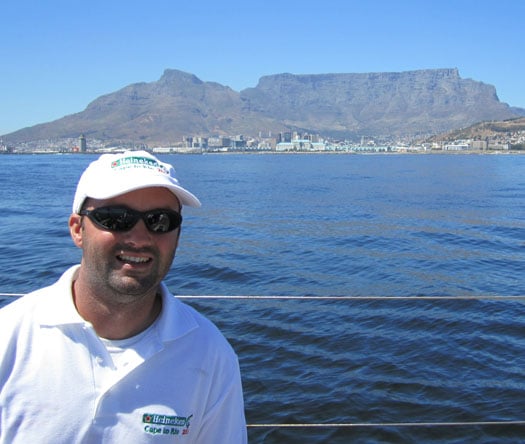
Richie Fearon of Lough Swilly YC, seen here kitted up off Cape Town for the Transatlantic race to Rio, navigated Tanit to the overall victory in the Round Ireland 2014
So how do you explain to such people, people who have become Round Ireland enthusiasts with all the zeal of recent converts, just why it is that Ireland's premier offshore event can barely attract a viable quorum when the yacht harbours of Europe are bursting with high-powered offshore racing boats which are constantly on the lookout for events worthy of their attention, not to mention commercial offshore racing schools and training programmes which need events like the Round Ireland Race to stay modestly in business?
How indeed, when we already have enough difficulty in explaining it all to ourselves. Inevitably, we have to look at the history, and the setting of that history. The last time I was at the Round Ireland Prize-Giving Dinner-Dance in Wicklow, there'd been enough participants from my home port of Howth in that year's race to make it worthwhile for us to hire a bus to go down through the Garden County for the party. We were in the midst of the Celtic Tiger years when people's expectations were becoming very pretentious, and I remember two foodies seated nearby in the bus pompously hoping to high heaven that the evening's meal wouldn't be the inevitable rural feast of beef or salmon.
But the charm of Wicklow town is that, though it's barely a forty minute drive from the capital, it is very much of the country - l'Irlande profonde as you might say. 'Tis far you are from big city notions of fancy menus to appeal to jaded metropolitan taste-buds. So it was indeed beef or salmon. Not that it really mattered that much to the crowd on the bus from Howth. They were well fuelled with on-board liquor by the time we got there, and the return journey in the small hours was made even longer by the need for frequent comfort stops, thus all they'd needed in the meal was absorbent food to mop up the booze.
Some things have changed greatly in the past few years, not least that there was so little Howth involvement in 2014's race that one very modest car would have done to get all the participants to last Saturday night's prize-giving dinner dance in Wicklow. But some things, thank goodness, don't change. It was still beef or salmon. And very good it was too, as salmon is excellent fish if you don't try to pretend that it's steak and grill it. That brings out its least attractive taste elements. But a baked darne of salmon with a well-judged sauce, such as we had last Saturday night, is a feast for a king. And I gathered the roast beef was very good too.
But it all reinforced the feeling that we were in the biggest hotel – the only hotel? - in a small Irish country town. Yet apart from the sailors at the night's event, there was nothing to suggest that Wicklow is a port, for there's something about the layout of the place which makes the harbour waterfront wellnigh invisible unless you seek it out. It's a delightful surprise when you do find it, but it's very much a little working port, rather than a natural focus for recreational boating and the biennial staging of one of the majorevents in the Irish sailing calendar.
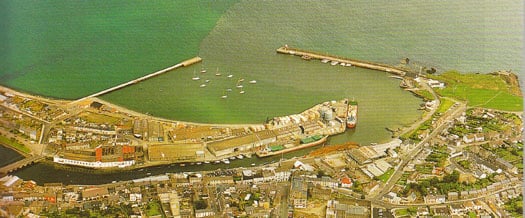
You almost have to take to the air to see that Wicklow is a little port town, for as this photo reveals, the main street turns its back very decisively on the workaday harbour in the Vartry River.
It was back in 1980 that Michael Jones of Wicklow Sailing Club took up boating magazine publisher Norman Barry's challenge for some Irish boat or sailing club, any maritime-minded club at all, to stage a round Ireland race. Jones went for the idea, and Wicklow have been running it every other year ever since. It may be the jewel in Irish offshore sailing's crown. But in Wicklow's little sailing club, it is the entire crown, and just about everything else in the club's jewel and regalia box as well.
Whether or not this is good for the general development of sailing in Wicklow is a moot point, but that's neither here nor there for the moment. What matters is that as far as the growth and development of the Round Ireland Race is concerned, in the early days of the 1980s the fact that Wicklow was a basic little commercial and fishing port with only the most rudimentary berthing facilities for recreational boating didn't really matter all that much, as most other harbours in Ireland were no better.
In 1982, the great Denis Doyle of Cork decided to give the race his full support with his almost-new Frers 51 Moonduster. Denis was someone who strongly supported local rights and legitimate claims, and he reckoned that the fact that Wicklow Sailing Club had filled the Round Ireland Race void, when larger longer-established clubs of national standing had failed to step up to the plate, was something which should be properly respected. So in his many subsequent participations in the Round Ireland Race, Moonduster would arrive into Wicklow several days in advance of the start, she would be given an inner harbour quayside berth of honour in a place as tidy as it could be made in a port which seems to specialise in messy cargoes, and Denis and his wife Mary would take up residence in a nearby B & B and become Honorary Citizens of the town until each race was started and well on its way.
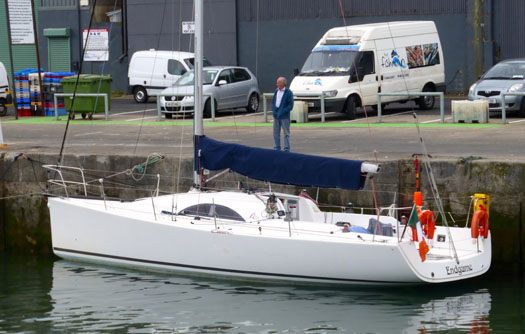
Like father, like son. Denis Doyle's son Frank's A35 Endgame from Crosshaven berthed in Wicklow waiting for the start of the Round Ireland Race 2014, in which she placed fourth overall and was a member of the winning team for the Kinsale YC Trophy. Photo: W M Nixon
It was an attitude which they brought to every venue where Moonduster was raced. The Doyles believed passionately that boosting the local economy should be something that ought to be a priority in any major sailing happening, wherever it might be staged. Denis had been doing the biennial Fastnet regularly for many years before he took up the Round Ireland race as well, and for a longtime beforehand he and Mary had also had the Honorary Citizen status in Cowes, as he would make a job of doing Cowes Week beforehand, living in digs in the town, while at race's end in Plymouth, there'd be a local commitment as well, albeit on a smaller scale.
This was all very well for Wicklow and the Round Ireland in the circumstance of the 1980s, but by the 1990s other ports were developing marinas and providing convenient facilities, yet Wicklow stubbornly stayed its own friendly but inconvenient self. When we look at the geography of the harbour, we can see why, and see all sorts of things that might have been done differently a very long time go.
For instance, when the Vikings were first invading and intent on making Wicklow one of their key ports, it could have been developed in a much more useful way if only the native Irish had made them welcome. Can't you just see it? "We'll overlook the rape and pillage for now, lads, these guys represent substantial inward investment". Just so. Had there been that far-sighted attitude, the locals could have invited the men in the longships to come on up the River Vartry, and into the magnificent expanse of the Broad Lough. What a marvellous vision that would have revealed. With some minor rock removal and a little bit of dredging in the entrance, it could be a wonderful extensive natural harbour in a beautiful setting. Had that happened, just think how differently the facilities of modern Wicklow harbour might now be.
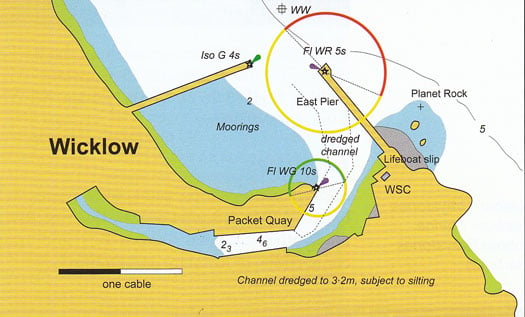
The navigable part of Wicklow Port as it is today. The water does not really come to a sudden straight-line stop as shown on the left – that's just the bridge. Plan courtesy Irish Cruising Club
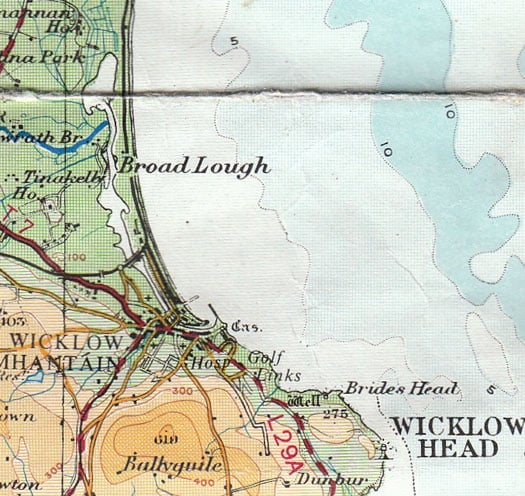
The bigger picture. Had the Vikings not been stopped such that they had to establish their settlement at the mouth of the Vartry River, they might have been able to create a much larger harbour settlement further in around the shores of the Broad Lough, with obvious advantages for Wicklow Port as it might have become today
Instead, the Vikings struggled ashore on the first available landing place at the first bend of the river, and established a beach-head which became such a successful little fort that eventually they were able to burn their boats. But by thattime, they were totally committed to having Wicklow town in its present cramped location. Access to the Broad Lough at high water (there's a very modest tidal range tidal) was soon restricted by the bridge, and then other river crossings, such that today nobody thinks of it as a potential harbour at all, if they ever did.
But meanwhile the current inner harbour is a cramped and dirty river which seems to be ignored by the town as much as possible, such that even the Bridge Tavern, the birthplace of Wicklow's most famous seafarer, Captain Robert Halpin of SS Great Eastern and trans-oceanic cable laying fame, turns its back firmly on the port. And as for the outer harbour, while it's a delightful place on a summer's day, it is not a serious proposition for berthing a large fleet of boats preparing for a major 704-mile offshore race, but people have to make do with it as best they can.
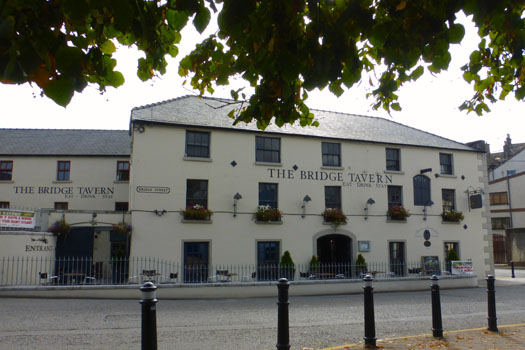
Despite being the birthplace of the most famous Wicklow seafarer, Captain Robert Halpin, the Bridge Tavern turns its back on the harbour. Photo: W M Nixon
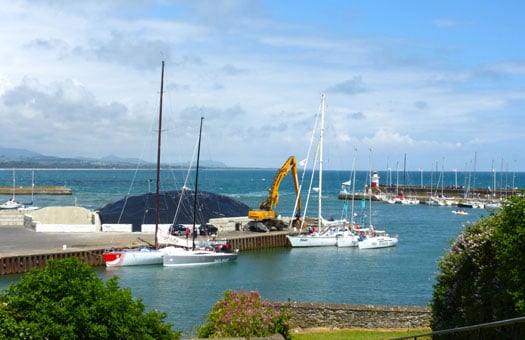
Wicklow's Outer Harbour on the morning of the Round Ireland race 2014 is a lovely sunny spot..............Photo: W M Nixon
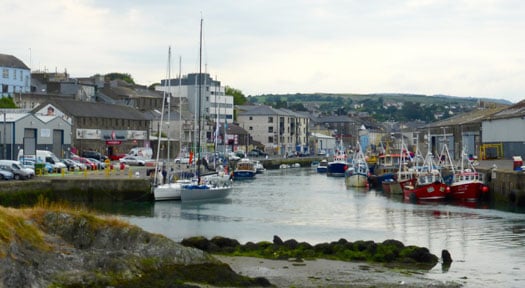
....but it is the inner harbour, shared with fishing and other commercial craft and assorted non-maritime quayside businesses, which will shelter the fleet preparing for the Round Ireland Race. Photo: W M Nixon
It was in the 1990s when the Round Ireland fleet was at its peak that the problems with the harbour's limited facilities were at their most acute, and it may be dormant memories of those difficult conditions which contribute to today's shortage of enthusiasm for the race. Back in the 1990s, the average cruiser-racer was not kitted out as a matter of course to RORC requirements, thus those undergoing their first scrutiny in order to be allowed to race round Ireland had to get to Wicklow several days in advance, and then often spendmoney like water to get up to scratch, the necessary bits and pieces being supplied by chandlers' vans parked on the quay.
It was crazy, not unlike a waterfront version of Ballinasloe Horse Fair - all that was missing was Madame Zara in her shiny caravan giving out nautical horoscopes in sepulchral tones for the wannabe Ireland circumnavigators. Perhaps she was there, but the two times I was going through the process with my own boat, it was so hectic I wouldn't have noticed. All I wanted to do was get to sea and away on the race, and get the filth of Wicklow harbour washed off the boat as soon as possible, as we'd drawn the short straw and had been berthed right in against the quay, so everyone has used our boat as a 35ft doormat on their way across to their own craft.
But the finish of the race at Wicklow – now that was and is completely different. The place seems to have transformed itself while you've been away bashing through sundry waters and a lot of the Atlantic in the intervening five days. Everyone is feeling like a million dollars, and Wicklow seems the only proper place in the whole wide world to finish a major offshore race. And as for the Round Ireland Prize Giving Dinner Dance, the venue of the Grand Hotel and beef or salmon for the meal is all part of the formula, it's central to the mystique of this extraordinary event.
In the days of the big entries with massive sponsorship from Cork Dry Gin, the prize-giving was Dublin-centred even if the race had started and finished in Wicklow. And the big bash in the city would start with a huge reception leading on into a gala dinner (I don't remember much dancing) in a glitzy Dublin hotel. In truth, it seemed a bit remote from little boats making their ways alone or in ones and twos back into Wicklow after the profoundly moving experience of racing right round our home island.
By the time you'd done all that, only others who have done the same could truly share your feelings about the experience. Big parties in anonymous city hotels were not the ideal setting for the Autumnal prize-giving and de-briefing. Thus the contemporary final hassle of getting down to Wicklow for the Round Ireland Dinner on a black November night in a veritable deluge of a downpour could be seen as the last stage of a long weeding-out process.
But once you're into the Grand Hotel and the party is under way, it's magic and the camaraderie really is quite something. Old rivalries and grievances fade away. It is also, to a remarkable extent, a family gathering – the number of family crews involved is surely exceptional. And the tone of it for 2014 is set by the presence of the winner of the KYC Trophy for the best three boat team, for the winners had as their top-placed boat the A35 Endgame, fourth overall and owner-skippered by Frank Doyle RCYC, son of Denis and Mary Doyle.
However, inevitably the status of the race and its future development and expansion is something which just won't go away. Any doubts about its importance were soon dispelled by considering the special guests at the dinner, as they included the President of the Irish Sailing Association David Lovegrove, the Vice Commodore of the Royal Ocean Racing Club Michael Boyd of the RIYC, and the Commodore of the Royal Irish Yacht Club, Jim Horan, whose club in 2014 was for the first time in association with Wicklow Sailing Club on the Round Ireland Race. The RIYC acted as hosting club in Dun Laoghaire for visiting boats which didn't want to go on down to Wicklow until shortly before the start, but wished toavail of modern marina facilities and the amenities of a large sailing port in the meantime.
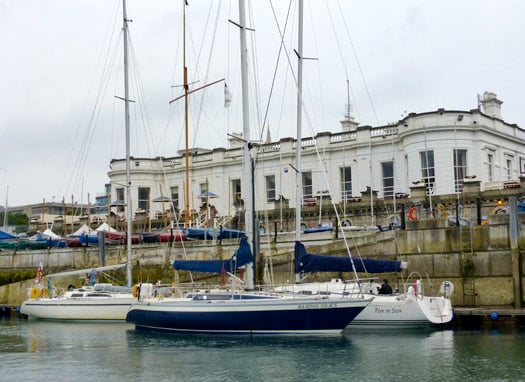
The switched-on crews going to Dun Laoghaire before the start of the Round Ireland Race 2014 knew that the best approach was to make themselves known at the Royal Irish YC and get a berth there, instead of allowing their boats to be banished to the "Siberia" of Dun Laoghaire Marina's remote visitors berths. Photo includes the MG38 McGregor IV from Essex which finished tenth overall (left), and the Oyster 37 Amazing Grace from Kerry, which had been in the frame but was forced to retire with equipment failure. Photo: W M Nixon
It was a partnership with potential, but it will need to be worked on. For although boats from other parts of Ireland knew that on arrival in Dun Laoghaire the secret of being well looked after was to make your number directly with the RIYC, boats from further afield coming into Dublin Bay tended to contact the marina, and thus they were stuck into Dun Laoghaire Marina's absurd visitors' berths, which are right at the very outer end of the pontoons, way out beyond acres of currently empty berths, such that it's said that anyone on them is one whole kilometre's walk from dry land.
Before the Round Ireland Race, the eventual winner Tanit was brought up from the Solent to Dun Laoghaire by a delivery crew who contacted the Marina Office, and she was stuck out in the Siberia of those Visitors Berths. It did mean that when she was first properly seen in Wicklow Harbour on the morning of the race, her impact as clearly an extremely attractive and very sound all round boat was all the greater. But nevertheless, if that is Dun Laoghaire Marina's idea of making visitors welcome, then they need to do something of a reality check, and it was a telling reminder that many Dun Laoghaire and Dublin Bay sailors are so absorbed in their own clearly defined and time-controlled activities afloatthat it leaves them with only limited attention for events outside their own sphere of interest.
As for Dun Laoghaire's general public, is there any interest at all? If the start of the Round Ireland Race was shifted to Dun Laoghaire, as some suggest, do you think the vast majority of the locals would take a blind bit of notice? At least in Wicklow they do make a bit of a fuss on the day of the start, with a community-sponsored fireworks display the night before.
In a final twist, in setting up the new Wicklow-Dun Laoghaire relationship, nobody had thought of the Greystones factor. Most had been unaware that the new Greystones marina is unexpectedly very deep. But such is the case, as I learned on Saturday night from the man from Newstalk. It's one of the reasons it cost the earth to build the little place. But it did mean that, in the buildup to the Round Ireland Race, while two of the deepest boats, the Volvo 70 Monster Project chartered by Wicklow's "Farmer" David Ryan, and the Farr 60 Newstalk, were unwilling to berth in Wicklow itself, they'd only to go a few miles north to find a handy berth in Greystones, where they were still very much in Wicklow county. There, they were the focus of much attention. For as we've discovered at Afloat.ie, if we lead a story #greystones, the level of interest is amazing.
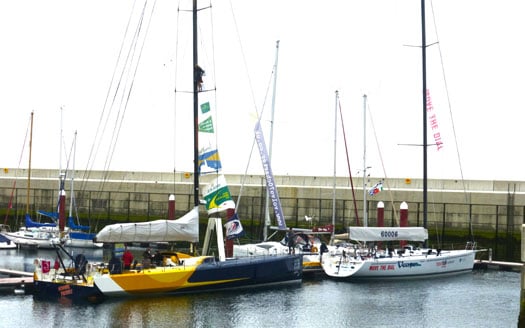
The exceptionally deep water in Greystones Marina provided trouble-free berthing for the Volvo 70 Monster Project and the Farr 60 Newstalk. Photo: W M Nixon
Perhaps after their attendance at the Round Ireland Dinner in Wicklow last Saturdaynight, Tanit's crew now have a better understanding of why the Round Ireland Race is in its present format. And I certainly understand why the level of close personal attention which goes into the race administration by the small team in Wicklow SC running it adds greatly to its appeal for dedicated participants. Before going to Wicklow, I'd been checking with the eternally obliging Sadie Phelan of the race team whether or not Richard Harris would be there, as I had to admit I thought his boat was only gorgeous. "Of course he'll be there" says Sadie, "and I'll put you at his table".
Not only that, but the winner Tanit's table and the runner-up Ruth's table were cheek by jowl, so much so that I was almost sitting at both of them. It would have taken a team of scribes to collate all the information flying back andforth, but everything was of interest.
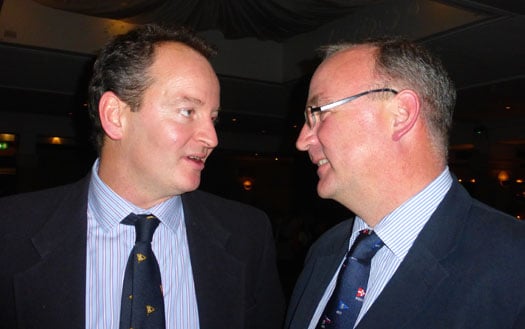
Just six minutes separated them at the end.....winner Richard Richard Harris of Tanit (left) and runner-up Liam Shanahan of Ruth at the Round Ireland prize-giving in Wicklow last Saturday night. Photo: W M Nixon
Richard (42) and his brother have owned Tanit for about twelve years, but as his brother is into gentler forms of sailing, the offshore campaigns are exclusively Richard's territory. In early sailing in the Clyde, they'd campaigned a Sweden 36 with their late father while Richard's own pet boat was a classic International OD. But as his interest in offshore racing grew, heidentified the Australian Murray Burns Dovell-designed Sydney 36 as ideal for their needs. He found there was only one in Europe, a 1996 one, little-used and in the Solent. They soon owned her, and changed her name to Tanit as the family firm is Clyde Leather, a vibrant firm which is the only suede tannery in Scotland.
Thus as raced in the Round Ireland, Tanit had the logo of Clyde Marine Leather on her topsides - a useful sideline is suede products for marine use, including a very nifty range of attractively-priced DIY kits for encasing your stainless-steel steering wheel in suede. Show me a boat which has a bare steel wheel, and I'll show you a boat which is on auto-pilot for an indecent amount of the time. But if you are doing the suede coat thing on your helm, be sure to cover the spokes as well, it makes all the difference for ultimate driver comfort.
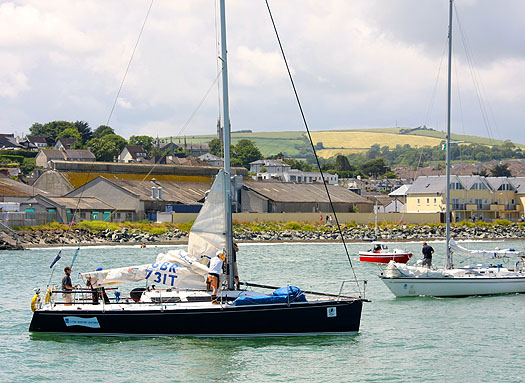
The boat from God knows where....Tanit (left) was an unknown quantity when she made her debut in Wicklow Harbour on the morning of the Round Ireland Race 2014, but father and son crew Derek & Conor Dillon's Dehler 34 Big Deal (right) from Foynes had already taken part in a couple of ISORA races, and went on to win the two-handed division and place 8th overall. Photo: Kevin Tracey
Gradually, they built up Tanit's campaigning in the Clyde, and most of the crew who currently race the boat have been together for seven years. They also chartered a boat to do the Hobart Race of 2008, but as Scottish offshore racing numbers declined, they decided to give it a whirl with the RORC fleets in the English Channel by moving Tanit down there. They found that the programme of concentrated doses of large-fleet intense offshore racing, all taking place at a venue two hours' flight from Glasgow, suited them very well – they could be totally domesticated when at home without the distraction of the boat being just half an hour's drive down the road.
The Sydney 36 of Tanit's type ceased production in 1997, the Sydney 36 you'll tend to come across now on Google is a new 1998 design. So when Tanit's rudder was wrecked after the 2011 Fastnet (a good race for them), it was something of a disaster as a replacement rudder could no longer be supplied off the shelf. It was even more of a disaster for the unfortunate woman who was driving her five-day-old Range Rover around the boatyard in Southampton where Tanit had been hoisted after returning from the Fastnet finish in Plymouth, for not only was her absurdly big shiny new vehicle severely damaged in somehow colliding with the rudder of the Scottish boat, but it turned out that an inevitably custom-built replacement would cost a cool 35K sterling for her insurance company, as that was one very special rudder.
It was a disaster all round, for by the time they'd identified a high tech builder of sufficient repute prepared to build the new rudder, they had missed most of the 2012 season. Then the 2013 Fastnet Race had too much reaching to suit them, as Tanit is at her best upwind and down. So with Richard's brother making louder noises about selling Tanit in order to suit his more sybaritic preferences afloat, the Round Ireland Race 2014 came up on the radar as being an opportunity for what might well be the last hurrah with a much-loved boat.
They needed a navigator, and preferably one with some experience of the Round Ireland course. Fortunately John Highcock of Saturn Sails in Largs, who regularly races with Tanit as one of those ace helmsmen who can seem to smooth the sea, had sailed with Richie Fearon and suggested him with the highest possible recommendation, so the Swilly man was brought on board.
The rest of the crew were complete round Ireland virgins, but they found the race suited their style and level of sailing very well indeed. In any Round Ireland Race, seasoned observers can usually identify beforehand the half dozen or so boats which will be serious contenders for the overall handicap prize, but which one actually wins will depend on the way the chips fall. But Tanit was something of an unknown, a wild card. Yet it wasn't very far into the race before it became clear that this was a good boat on top of her game, if things came right she'd the makings of a winner.
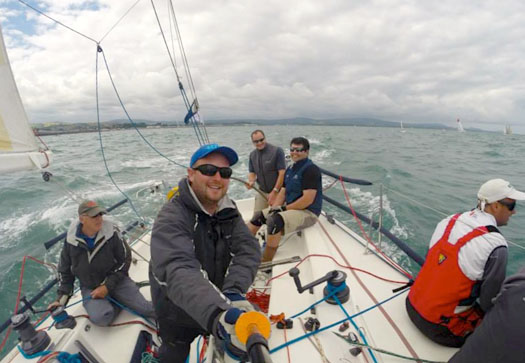
Tanit settling in after the start. The quicker they got south, the sooner they got back into the sunshine........
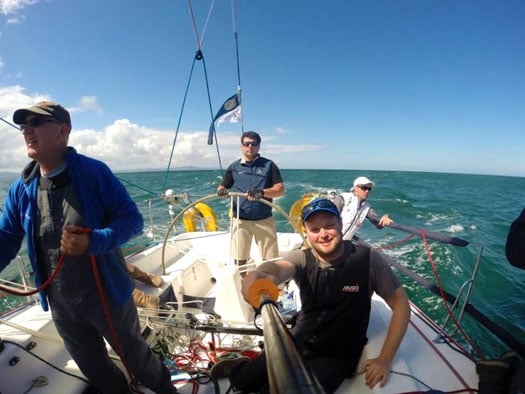
....and nearing the Tuskar Rock on the Saturday evening, they were back in sunshine, and well in contention on the leaderboard.
Within the limits of having a sensible boat which professionals would describe as a comfortable cruiser-racer, they campaign flat out. All meals are built around expeditionary and military Ration Packs, which can be quite expensive to buy in ordinary circumstances, but if you can show they're going to be used for a worthy objective, it's possible to swing a deal, and as Richard's wife Vicky is a physiotherapist who is involved with military reserves, the value of Tanit's campaigns is accepted in the right places. The result is a nourishing supply of reasonably attractive easy-prepare instant food which, as Richard reports still with some wonderment, makes no mess at all in and around the galley, yet keeps the crew on full power.
By the time they got up off the Donegal coast, Tanit was right in there, battling with the defending champion, the Gouy family's Ker 39 Inis Mor, for the overall handicap lead, while up ahead the two biggies, Teng Tools (Enda O'Coineen and Eamonn Crosbie) and the Volvo 70 Monster Project, with David Ryan of Wicklow, kept finding new calms as they tried to shake off the smaller craft.
It was a slow race, but Richie Fearon managed to place Tanit so that she stayed ahead of a calm up in his home waters, and was keeping station on Inis Mor very handily indeed, while the gap with boats astern widened all the time. Or so it seemed. But then the Round Ireland Race pulled one of its regular tricks, and Liam Shanahan and his team on the J/109 Ruth began to shift before they'd even got past Tory Island, and they appeared to carry a useful breeze and a fairtide the whole way from Donegal into the Irish Sea, or at least that's how it looked to the rest of the fleet.
But in closing in over the final stage from Rockabill to Wicklow, navigator Fearon – who was incubating a nasty virus which required antibiotic treatment for a week after the race - convinced Tanit's skipper that they should stay offshore, while Ruth – which seemed to have the race nicely in the bag – followed the Irish habit of hugging the coast. Inis Mor was already finished on Friday morning, but Tanit knew she was beatable by them, and when they came across the line at 1030, it was to move into the CT lead. And going offshore proved to have been their win move.
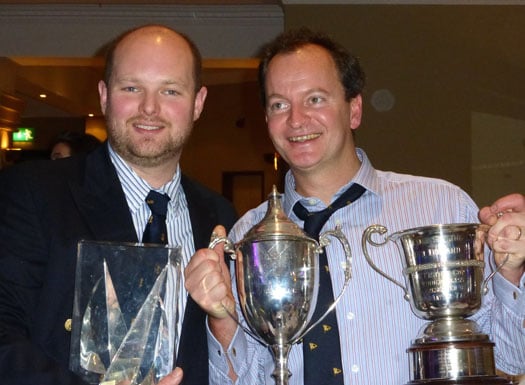
Trophies of the chase – crewman Chris Frize (left) and skipper Richard Harris with some of Tanit's prizes in Wicklow last Saturday night. Photo: W M Nixon
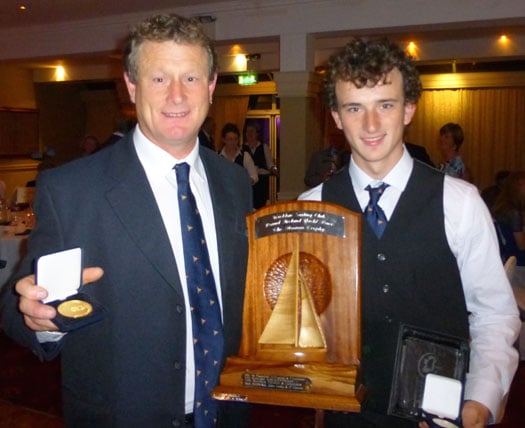
Family effort. Father and son team of Derek and Conor Dillon from Listowel in Kerry (they sail from Foynes) won the two-handed division with their Dehler 34 Big Deal, and placed 8th overall. Photo: W M Nixon
It was a time of screaming frustration for Ruth. She'd been crawling along near Bray Head, barely 15 miles from the finish, as long ago as 0700. She rated only 1.016 to the 1.051 of Tanit. A finish in the middle of lunchtime would do fine. It was so near. It was so far. Finally they got to Wicklow, but Tanit had them beaten by six minutes. Then for the Scottish boat there was just the chance that Ian Hickey's very low-rated veteran Granada 38 Cavatina might do it again. But the wind ran out for her too. Meanwhile Frank Doyle's Endgame came in at mid-afternoon to slot into fourth on CT behind Inis Mor, but Cavatina was fifth, all of five hours corrected astern of Tanit. The Scottish boat was now unbeatable leader.
Tanit's crew for this classic sailing of a true offshore classic was Richard Harris, Richie Fearon, John Highcock, Alan Macleod, Chris Frize, Andy Knowles and Ian Walker. They've a lovely boat of which they're justifiably very fond, but reality has intruded, and now she is indeed for sale. The price is 48K sterling which seems to me very reasonable when you remember that she is remarkably comfortable to sail, that sails and gear have been regularly up-dated, and that we know for certain that the rudder alone is worth 35K.......She's conveniently located for an Irish potential owner, as she's currently ashore in Glasgow. Certainly she has a performance weakness, for as Richard admits, she'll easily get up to 7 knots on a reach, but stubbornly stays there and goes no faster, yet if you harden on to the wind, she'll still be doing 7 knots. But if you go downwind, then whoosh – it's a horizon job on most other boats. Be careful what you wish for, though. With a boat like Tanit in an average fleet, there'll be no excuse for not doing well......
The rest of the trophy placings are here, and on Saturday night they were one lovely compact crowd of people. The family emphasis was inescapable, and it was a particular pleasure to meet the Kerry duo, father and son crew Derek and Conor Dillon from Listowel, who sail out of Foynes in their Dehler 34 Big Deal. In 2015, they plan to take on the two-handed division in the Fastnet, so getting 8th overall and winning the two-handed class in the Round Ireland 2014 was part of a very useful campaign trail.
Finally, as to how to keep the Round Ireland race's distinctive Wicklow flavour while allowing the entry numbers enough room to comfortably expand, it's such a tricky question that it will require a radical solution. A very radical solution. The mistakes of the Vikings must be undone. The Vartry entrance must be dredged, The bridges must all be removed. And the Broad Lough must be tastefully developed to give Wicklow the harbour it deserves, and the Wicklow Round Ireland Race the facilities it needs to cater for a fleet of a hundred and more boats. Simple, really.
ROUND IRELAND RACE TROPHY WINNERS 2014
Line Honours: Denis Doyle Cup - Monster Project (David Ryan, WSC)
IRC Class CK: CK Cup – Monster Project
IRC Class Z: Class Z Cup - Newstalk for Adrenalin (Joe McDonald, NYC)
IRC Class 1: Tuskar Cup – Inis Mor (Laurent Gouy, CBC)
IRC Class 2: Fastnet Cup – Tanit (R Harris, SYC)
IRC Class 3: Skelligs Cup – Ruth (L Shanahan, NYC)
IRC Class 4: Tory Island Cup – Cavatina (I Hickey, RCYC)
Class 5 (Cruiser HF) – Cavatina
Class 6 (pre 1987) Michael Jones Trophy – Cavatina
Class 7 (two-handed) Noonan Trophy – Big Deal (D & C Dillon, FYC)
ICRA Trophy (best Irish boat) - Ruth
Ladies Award: Mizen Head Trophy - Pyxis (Kirsteen Donaldson)
ISORA Award – Ruth
Team Award: Kinsale YC Cup – Endgame (F Doyle), Wild Spirit (P Jackson) & Fujitsu (D B Cattle).
IRC Overall: Norman Barry Trophy – Tanit
Round Ireland Overall: Wicklow Cup - Tanit
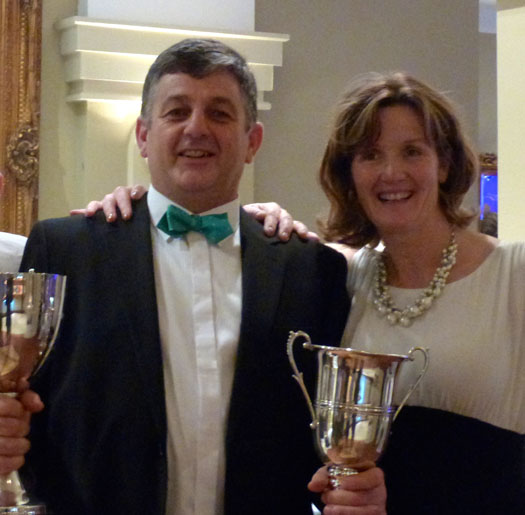
Monster boat, monster prizes. Line honours and Class C winner David Ryan of Wicklow, who raced the Volvo 70 Monster Project to success, with Roisin Scanlon, also WSC, who crewed on the Monster during the Round Ireland Race Photo: W M Nixon
Boating Visitors To Ireland's South Coast Get Mixed Welcome Messages
#marinetourism – Ireland's south coast provides an almost infinite variety of harbours, natural havens, and extensive areas of interesting sailing water. These cater for boat enthusiasts of all kinds, with craft of every type. So how does the welcome for visitors shape up? W M Nixon contrasts the different hospitality styles of four attractive ports.
The word on the grapevine that the Ballydehob Old Boat festival had taken place arrived with an intriguing photo from Anthony O'Leary. It had been noted in the interview with him immediately after he had led the team in Ireland's Commodore Cup Victory, that while he was trying to unwind for a while, it's not really in the O'Leary makeup to relax, and soon his mind was busy with new ideas of nautical interest.
Nevertheless he was cruising gently in early August down towards West Cork in the family's handsome big Nelson powercruiser Irish Mist, a fast and able vessel which his father Archie and mates like Mick Ahern once took right round Ireland in a settled springtime spell of weather, just to be in Dublin to watch Cork Con play rugby in some major championship at Lansdowne Road.
As it turned out, this year Irish Mist was getting down west ultimately to be in Baltimore for the 1720 Nationals in late August, which O'Leary duly won. But from time to time, he flashed back some photos of interesting boats met along the way, and one which really rang the bell was a little Ette Class clinker-built gunter-rigged sloop sailing in Castlehaven.
The Ette class originated way way back, when two keen dinghy cruising types sailed their little dinghy into Castlehaven, and the Castletownshend locals in the South Cork Sailing Club were so taken by the boat that they commissioned the waterfront boatbuilders, the O'Mahony brothers, to build some sister ships as the basis of a class.
All the new boats' names ended in "ette". And the class survived for many years, though at times the Ettes were hanging on by a thread. But recently it has had a fresh lease of life with new examples of what is now a classic dinghy being built by Lui Ferreira of Ballydehob, who last came through this parish when, in 2012, he put the first teak deck on a vintage Howth 17, the syndicate-owned Deilginis.
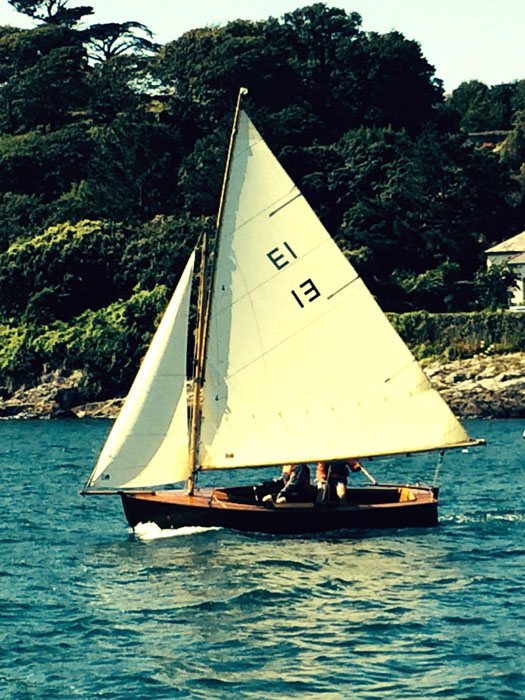
Perfection of summer – an Ette class in her home waters of Castlehaven. Photo: Anthony O'Leary
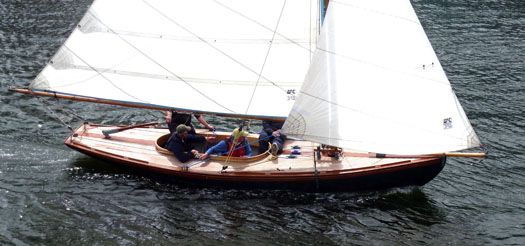 Rui Ferreira, builder in Ballydehob of the Ette Class, also put this teak deck on the 107-year-old Howth 17 Deilginis in 2012. Photo: W M Nixon
Rui Ferreira, builder in Ballydehob of the Ette Class, also put this teak deck on the 107-year-old Howth 17 Deilginis in 2012. Photo: W M Nixon
A Howth 17 looks well no matter how you photo her. But an Ette is a quirky little thing which can sometimes look odd from the wrong angle. Yet in a flash of inspiration, the Captain of the Commodore's Cup team took up his iPhone as an Ette came bustling down Castlehaven on fine sunny morning, and we got what I reckon to be one of the best photos of an Ette under way ever obtained – plus it gets the very essence of summer in Castlehaven.
The next O'Leary snap some days later was just briefly titled: "The Ballydehob Old Boat Festival, Irish Mist in archway second left". What was going on here? We'd heard vague stories about a very relaxed assembling of boat at high water at the drying quay at Ballydehob, but the O'Leary photo hinted at serious numbers and a high level of organization.
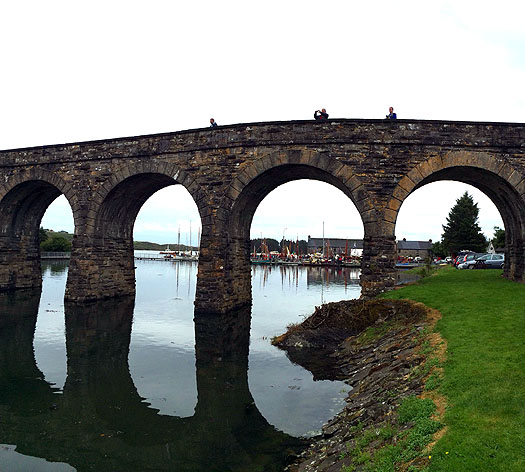
The teaser photo – first intimations of this year's Ballydehob Gathering of the Boats, with the O'Leary family's motor-cruiser Irish Mist (framed in the second arch from left) joining an eclectic group of 74 boats for a couple of hours at top of the tide. Photo; Anthony O'Leary
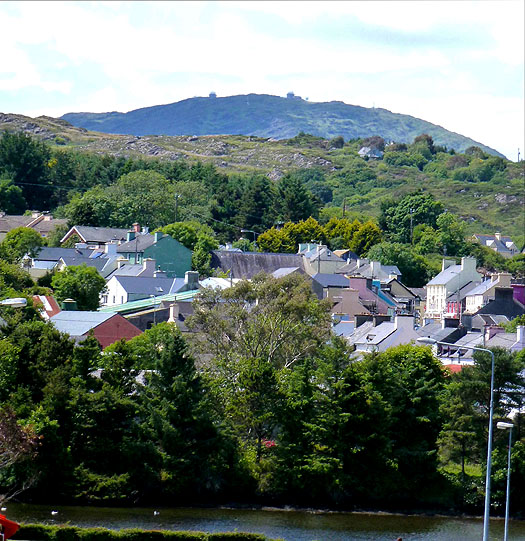 This is most people's image of Ballydehob, crowded and very rural, with Mount Gabriel beyond. Only the more observant will notice the tidal river in the foreground. Photo: W M Nixon
This is most people's image of Ballydehob, crowded and very rural, with Mount Gabriel beyond. Only the more observant will notice the tidal river in the foreground. Photo: W M Nixon
To begin with, most casual visitors would scarcely think of Ballydehob as a seaport at all. Rather, it's the very essence of rural West Cork, a crowded little village where "laid-back" is the default mode, and it has been so for some time. It reached something of an apotheosis when Annie Barry (she's one of the Fergusons of Gubbeen Cheese) was running her wonderful Annie's restaurant on one side of the winding main street, and the Levis sisters Julia and Nell, feisty little ladies of mature years, were running Levis's pub across the way.
Julia and Nan were splendid folk of considerable standing, and it's said the pair of them were once squired to the West Cork Hunt Ball in Skibbereen by Jeremy Irons of Kilcoe Castle a few miles along the coast. As for the setup in Ballydehob, space was so limited in the restaurant that, having checked out your booking, you simply took up station in leisurely style across the street in the pub with Annie's menus and an aperitif or two, then Annie would come across the road and discuss your order, and a delightful evening would continue late into the night.
Alas, for some year now Annie's has been closed, though everyone lives in hope of somebody re-opening it. And in the pub, the old ladies have passed on. But now it's run by a great-nephew, and very successfully too. We got ourselves in there late on a velvet July evening this year to find the place was heaving with youth and beauty and high fashion in casual style - achingly trendy it has become.
It could have been a traditional local in any of the world's fashionable holiday areas except for one thing. A ball of fur, a terrier of some kind, emerged from among people's legs and barked its head off at me. I assumed it was because I carried a whiff of our own little Jack Russell. But the blushing girl owner told me with a big smile that her little dog must have thought I was a priest. Only along Ireland's south coast, near some former or still surviving Protestant enclave, would you have heard that particular excuse.
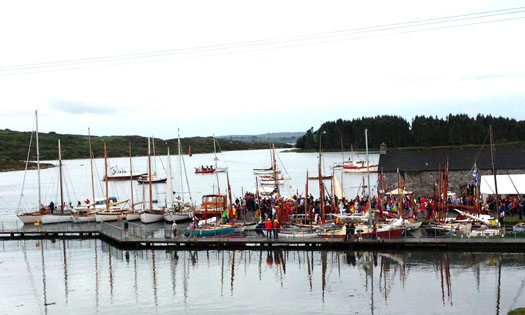 The old dock at Ballydehob is well able to receive a very varied fleet, seen here from the old railway viaduct Photo: Miriam Jones
The old dock at Ballydehob is well able to receive a very varied fleet, seen here from the old railway viaduct Photo: Miriam Jones
Just along the river from these scenes of hospitality and minor mayhem, immediately below the mighty railway viaduct which seems to be so disproportionate for the long-gone needs of the little West Cork Railway, there's Ballydehob Harbour. Time was when it was key to the place's economy, and it was in the late 1930s, only a year or so before World War II, that the Brooklands, the last surviving sail-only coasting schooner to deliver cargoes to West Cork, made her way up the winding estuary at the head of Roaringwater Bay (it's named for the Roaringwater River, much of the bay behind Carbery's Hundred Isles is well sheltered), to anchor just off the quay, as she was too deep to berth alongside.
The Brooklands was owned and skippered by Tom Creenan of Ballinacurra in the inner northeast reaches of Cork Harbour, but it was from Birkenhead or Goole on the Mersey that she'd bring her welcome cargoes of coal, a challenging passage at the best of times. At Ballydehob, while smaller cargo-carriers could get alongside the old quay, the Brooklands discharged her cargo into the multi-functional barge-type vessel known the Sandboat.
She was used by her owners, the Levis family, for just about everything, but primarily for going out among the islands towards high water, running up on a clean beach, then laboriously shovelling sand into the hold until the tide returned and the Sandboat could be floated off and piloted back to the quay where her eventually very useful cargo would be shovelled ashore to become builders' supplies.
The Sandboat was Queen of the Fleet at Ballydehob, and she played such a central role in the Levis family's life that Old Boat Festival organiser Cormac Levis's brother calls his pub in Ballydehob the Sandboat.
As for how Cormac himelf first got the notion for the Ballydehob Gathering of the Boats, he has been a tower of strength in the Traditional Boat movement, particularly in West Cork but also throughout Ireland, for many years. And with others following his example in restoring or even building new sailing lobster boats to traditional design, he suggested that getting together at Ballydehob during the little town's time-honoured summer festival around August 15th might hit the spot. And for the first one in 2004 –making this year's the tenth anniversary - they assembled nine boats, which was considered pretty good going.
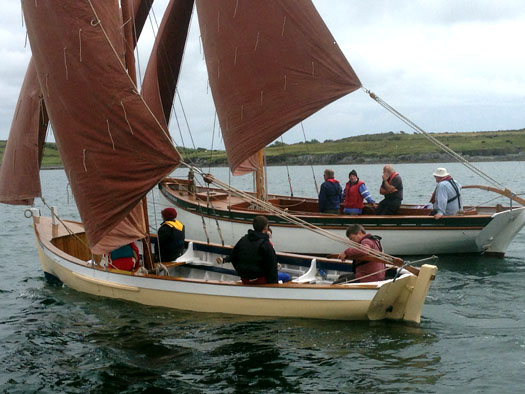
Close-up on Cormac Levis's lobster boat, which led the way for the first gathering of traditional craft at Ballydehob in 2004. Photo: Brian Marten
From it, they learnt that, for the future, while the aspiration would of course be for quiet and easy-going organization under a light hand, underneath it all there'd have to be efficiency, always with an eye on the clock. Although the tidal window is more than two hours for most boats, they've successfully accommodated modern yachts up to two metres draft without anyone being left behind stuck on the mud. But with limited manoeuvring space in both the harbour area and the channel, once the witching hour of high water is upon the fleet, it's time to start thinking about an orderly departure after two solid hours and more of good crack, mighty barbecues, and much interest in an examination of other people's traditional and classic boats.

Even among the sister-ships of the lobster fleet, many individual variants in hull lines and rig are apparent. Photo: Brian Marten
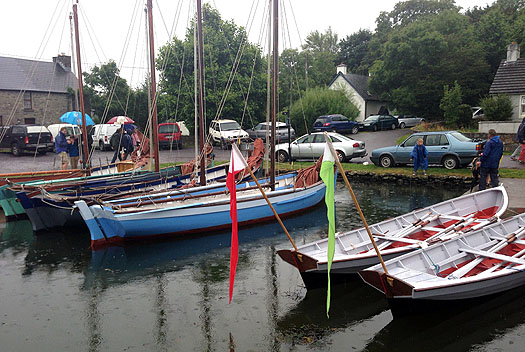
Just to add to the variety and colour, the Ilen Trust from Limerick brought their much-travelled Shannon Gandelows (right) to Ballydehob. Their stylish pennants are a legacy of heir successful visit to Venice at the end of April this year. Photo: Gary MacMahon
So the crucial thing is to select the ideal Saturday nearest to August 15th with a good big tide in mid-afternoon. As the Boat Gathering is such a force in its own right, they can range quite extensively on either side of August 15th, and to date the earliest has been August 8th, while the latest was August 21st.
This year's was Saturday August 9th, and while there may have been rain later in the day despite West Cork having much more sunshine in August than almost any other part of the country, no-body now remembers the rain as they recall the sheer fun and sense of community of what has been described by Tiernan Roe, another of the quality boat-builders of Ballydehob, as the "shortest bestest Boat Festival in the World".
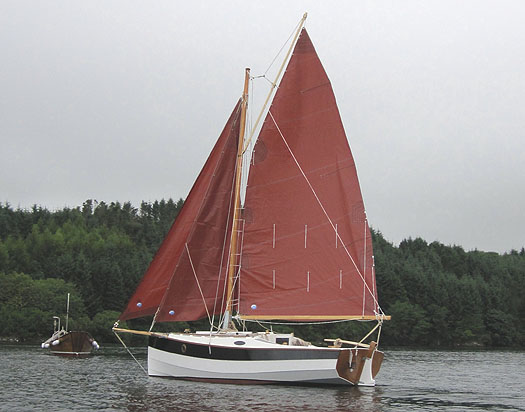
Yet another creation of the active Ballydehob boat-building scene. This is an attractive little Cape Henry 21 cutter lunched in June by Tiernan Roe of Roe Boats. Photo: Tiernan Roe
For this year, it attracted 75 boats, though admittedly last year's record entry of 50 boats was greatly enhanced by this year's decision by the Drascome Lugger Association to combine Ballydehob in their 2014 cruise-in-company in West Cork, thereby adding 27 boats at a stroke.
But even with 27 boats of one class, the variety across the fleet as a whole was remarkable. So how do they assemble such a disparate fleet of boats with obviously highly-individual skippers, in such a quietly efficient way? For you'll never see or hear the Ballydehob Gathering of the Boats being publicly advertised all that much beforehand.
The method is perfectly simple. Everyone with an interest will know it is likely to be coming up on the agenda. So a month and more beforehand, Cormac will text them with the final date on a need-to-know basis. It works, and it sets the tone of quiet consideration for others and their boats in a very special festival in which some quiet sponsorship by CH Marine and West Cork-based German traditional boat fan Thomas Drewes sees that all participants get mementoes including cherished T-shirts (definitely not for general release), while barbecue facilities keep the good humour buzzing until everyone departs in style for their anchorage for the night, for although most boats hope to be berthed in Ballydehob on the big day more two hours hours before high water, once the ebb has started the channel has become much less forgiving about any pilotage errors.
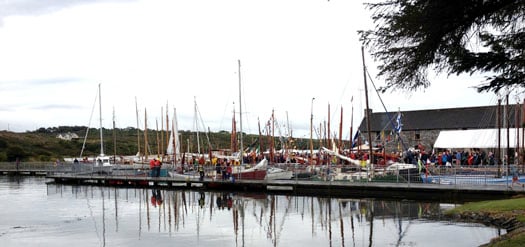
They're all here, as neatly berthed as you could please, but getting them away as the ebb starts requires good seamanship and boat-handling skills. Photo: Miriam Jones
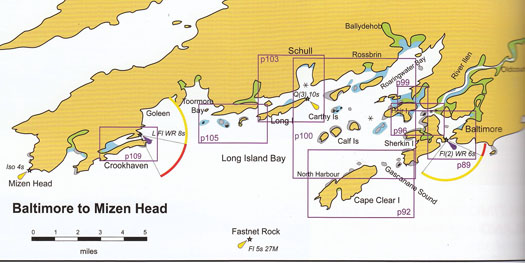
Ballydehob's central position in a hugely varied and welcoming crusing coast is emphasized by the number of other harbour chartlets indicated in this plan of the prime cruising area of West Cork. Plan Courtesy Irish Cruising Club
It's good to see a locally-focussed event like this now coming of age with a very healthy turnout. Eastward along the south coast, last weekend saw another event which will surely grow in stature and numbers, the second staging of Y2V Cruise-in-Company on the River Blackwater up the estuary from East Cork to West Waterford, as a flotilla of ten boats - eight GP14s, a Mermaid and a Feva – sailed up-river from Youghal to Villierstown.
It has been promoted by Youghal schoolboy GP 14 skipper Adrian Lee, and last year the inaugural tiny flotilla managed most of the sailable river by going to the bridge at Cappoquin before returning downriver to Villierstown. This year it achieved deserved support from the GP 14 class, with the furthest road-trailed from sea level being incoming Irish GP 14 Association President Stephen Boyle from Sutton DC, while the furthest-travelled in terms of elevation above sea level were the Blessington group, who came down from the Wicklow Hills with their Geeps and included Richard Street and kids (see again this blog on 26th July), and a brand new Duffin boat belonging to Simon Culley and Libby Tierney.
As for seniority, the classic of the class was a 60-year-old beautifully-restored Bell Woodworking GP 14 owned and skippered by 16-year-old Jack Nolan, another of that group of Youghal youngsters who are taking local dinghy sailing forward with gusto, while further variety was provided by Norman Lee of Greystones, his crew including the inevitable family pooches which are such a part of the GP 14 scene.
The sailing was mixed – as Norman said, in a river the wind will always be ahead some time, and though we think of the secret Blackwater Estuary as being fairly straight, in fact there are some quite significant curves. It took about four-and-a-half hours to sail up, and a brisker four hours to return on Sunday morning's ebb.
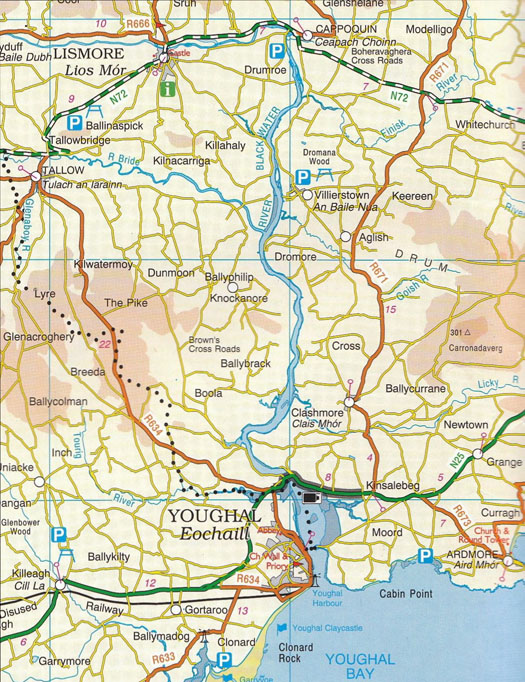
The secret waterway – the Blackwater Estuary from Youghal up to Cappoquin and almost to Lismore is one of Ireland's least-sailed rivers
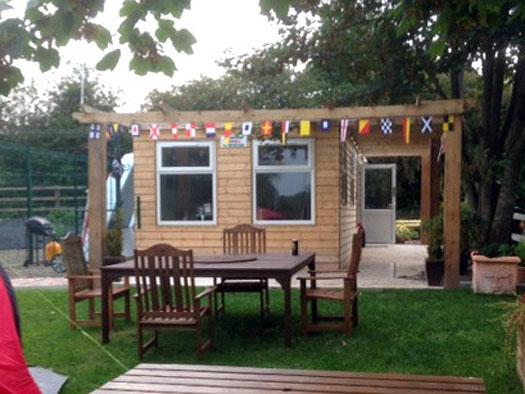
Villierstown's new clubhouse, open only three weeks, was ready and willing to make welcome the crews who had sailed up from Youghal. Photo: Norman Lee
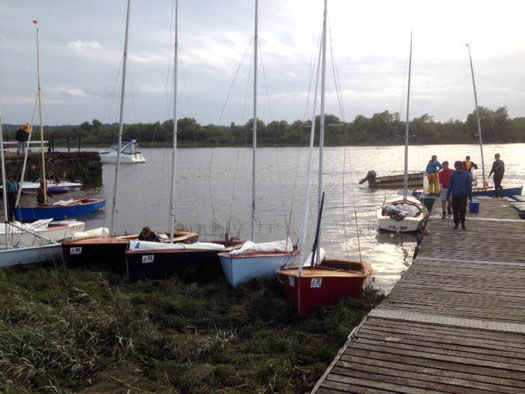
The new facility, Villierstown's "floating pier"
(right), was originally the in-harbour pontoon at Dungarvan SC. Photo: Norman Lee
At Villierstown, the new clubhouse of the Villierstown Boating & Activites Cub had been open only three short weeks, but they've made good use of a sports council grant, and it well fulfills a multi-purpose role, including providing the hospitality needed by sailing campers, with Paul Virtue and his wife Caroline organising a fine feast in the clubhouse on the Saturday night, and an enormous breakfast on Sunday to send them on their way downriver to round out an event which has future annual success written all over it.
One of the reasons it all went so well was that the slightly cogglesome little plastic floating jetty, along which the sailors of Villierstown used to access their small boats, has been replaced by a proper pontoon which the club acquired when Dungarvan SC eastward along the coast up-graded their in-harbour pontoon. In fact, Dungarvan support for the development of Blackwater sailing didn't stop there, as one of the fleet in the Y2V was a vintage Dungarvan-based Mermaid in which owner Eugene Burke has cruised the entire south coast between Ballycotton and Kilmore Quay.
The boat is Akita, Mermaid No. 85, and she has certainly been around, as she was built in the Barkyard in Skerries in 1953 by Joe and Matt Boylan. The Barkyard was originally the place where the Skerries-based coasting schooners and fishing boats had their sails preserved against rot by tanning with bark, but in the 1950s the now redundant premises were used to build some of the eventually enormous fleet of Skerries Mermaids through a boat-building class run by the colourful Jem Kearney.
The Fingal region around Skerries and Rush continues to be the great heartland of the Mermaids, with some very racy boats built in the old mill at Rogerstown recently, but despite the modern challenge, this year's Mermaid Week at Rush saw the champion emerge in the form of Jonathan O'Rourke of the National YC with his vintage boat, one of the few Mermaid sailors still in Dun Laoghaire.
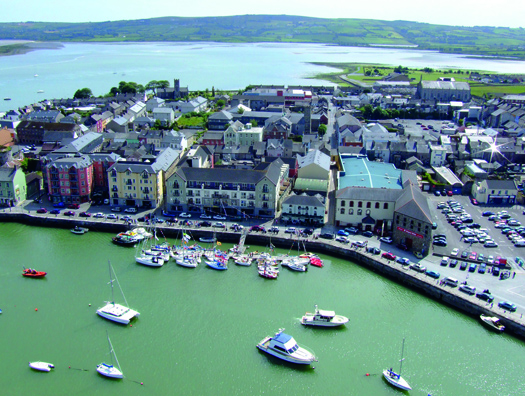
The welcoming port. Despite its tidal limitations, Dungarvan lays on the welcome in a big way. This shows a visiting fleet at the original pontoon, which has now been moved to Villierstown. Photo Kevin Dwyer, courtesy Irish Cruising Club
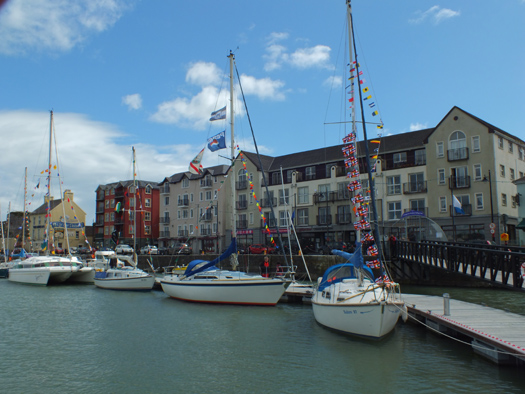
Dungarvan SC's new in-harbour pontoon has much improved the alongside berthing space, but unfortunately the local Council wouldn't permit dredging to improve access.......Photo: Donal Walsh
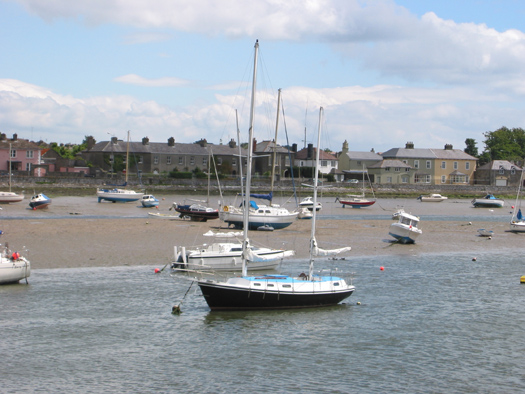
....and thus the reality for most boats in the Inner Harbour is a drying berth.......... Photo: W M Nixon
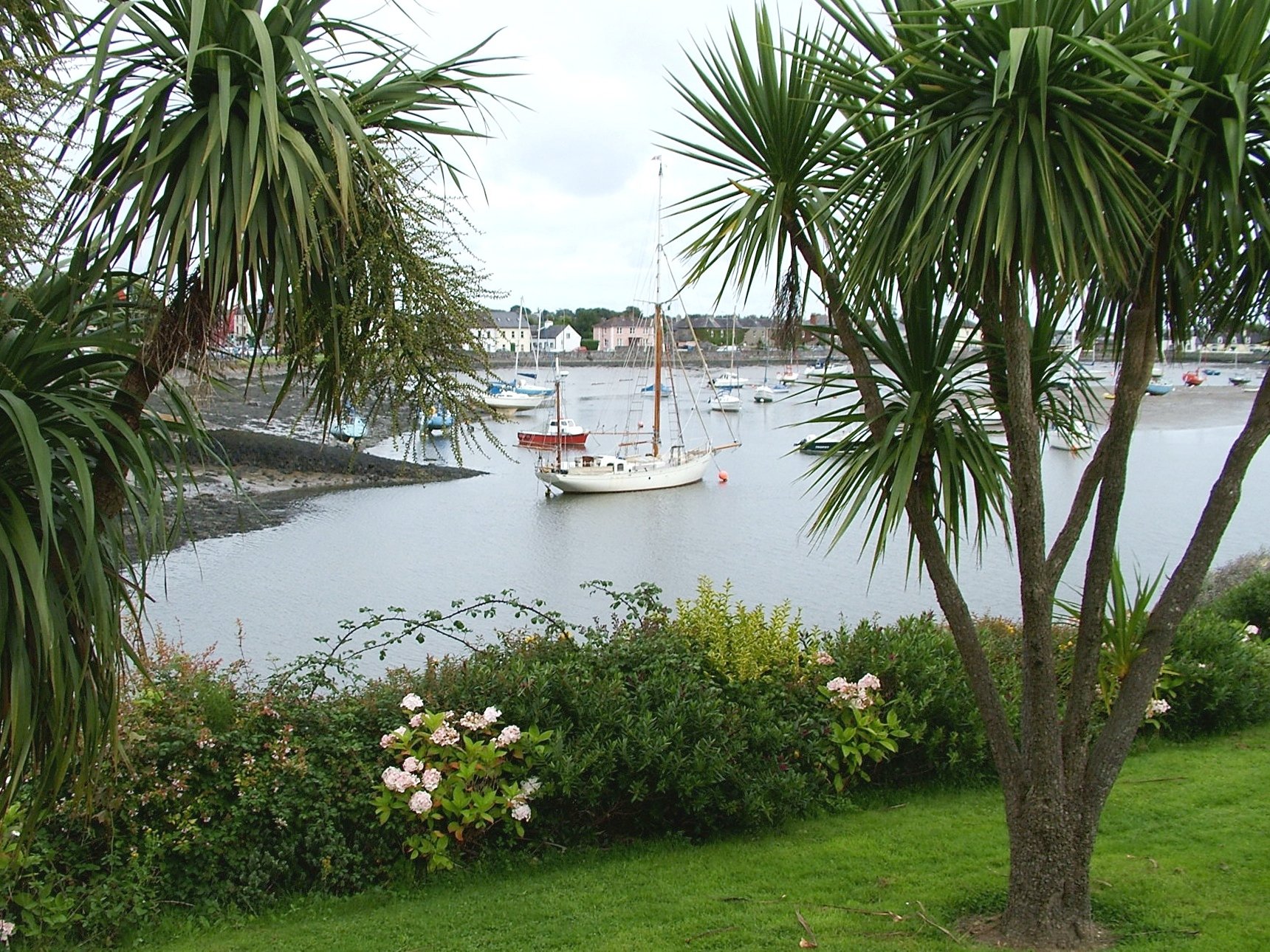
....but if you've access to local knowledge, there is a deep pool just below the bridge........Photo: Donal Walsh
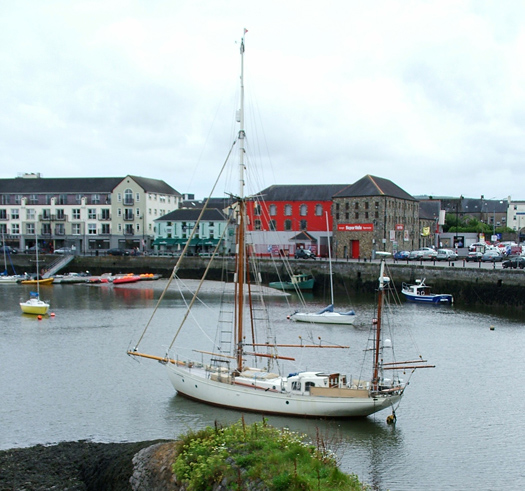
.....and here the Northwest Passage transiting 44ft steel gaff yawl Young Larry is visiting in comfort and style. Photo: Donal Walsh
Meanwhile in Dungarvan the club's hopes of doing a bit of dredging to improve access to their extended in-harbour pontoon was stymied when the council said they wouldn't permit any salt-contaminated sludge being brought up onto the quay. But despite its tidl limitations, it's a hugely hospitable place, and if you do take the ground at the pontoon, it's mostly soft and forgiving mud which enables you to sit in relative comfort. Certainly some very substantial cruising boat have overnighted here to enjoy the fine pubs both on the waterfront waterfront and in the town, while culinary standards are set by Paul Flynn's famous restaurant The Tannery just round the corner.
Nevertheless if you absolutely won't let your boat dry out, leading Dungarvan cruising man Donal Walsh (he has just returned from an epic round Ireland and Britain clockwise cruise with his Moody 31 Lady Kate) well knows the deep pool across the harbour close under the bridge, and he saw to it that his brother-in-law Andrew Wilkes and sister Maire Breathnaith found a secure berth there for their hefty 44ft steel-built gaff yawl Young Larry, a boat in which they transited the Northwest Passage, but she looks well at home in Dungarvan with its fine tradition of first class locally-based trading schooners.
In moving along the south coast, we find that when possible, they'll lay out the welcome mat big-time in Ballydehob, Youghal, Villierstown and Dungarvan, despite the fact that all four places are restricted in what they can do by the exigencies of tide.
So how are things working out in Dunmore East, the one port which has the potential to be one of the most welcoming and accessible all-tide sailing and fishing ports along the entire south coast?
Despite this potential, the under-development of its facilities, fuelled by a sometimes poisonous attitude between fishermen and other harbour users, has provided recreational visitors with often unpleasant memories. In trying to understand why this might be so, we have to understand how Dunmore East came to get its pretty little harbour. When it was built in the first half of the 19th Century, it was not – as is commonly supposed – built for the benefit of fishermen. The horrible fact is that fishermen came so far down the pecking order that they just had to make do for themselves as best they could.
The handsome new pier at Dunmore East, designed by Alexander Nimmo who is best known for developing Tobermory in Scotland and many places in Galway including Roundstone, was constructed exclusively for the use of the new fast sailing cross-channel packet boats serving the top people of Waterford in their trading and communication with Britain, while the unfortunate local fishermen were forced to keep their boats in the limited shelter of The Cove to the north of it, and haul them on the exposed beaches at The Strand and Councillors Strand.
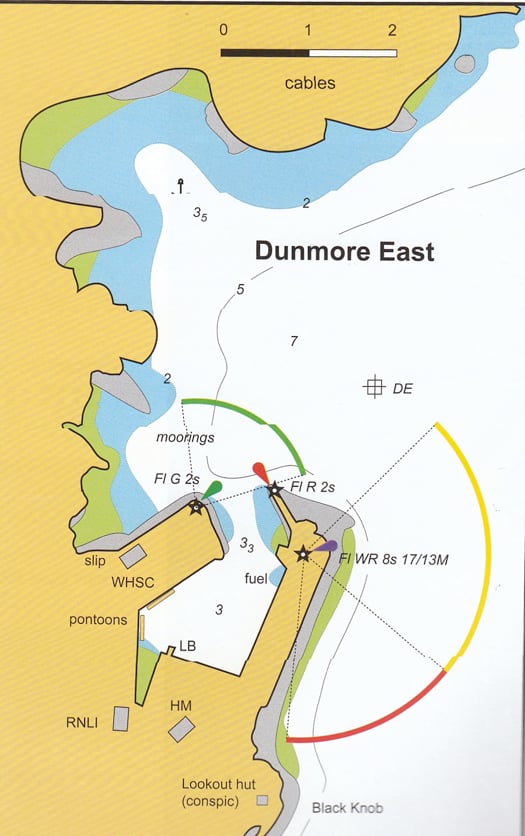
Dunmore East's substantial pier was new-built originally to provide a port for cross-channel sailing Packet Boats, serving Waterford ten miles up the road. When this was its primary function, any local fishermen were banished to the poorly-sheltered coves to the north, with their boats being hauled up on the exposed beaches beyond. Plan courtesy Irish Cruising Club
Soon, however, steam driven packet boats were able to go conveniently all the way up to Waterford, and Dunmore East was redundant as a packet-boat harbour. But it was only with reluctance that fishing boat were allowed to start using it, as the Royal Navy would have been keeping an eye on its possibilities for their own occasional use.
Yet down the years, the idea has developed that Dunmore East was always primarily a fishing harbour, and to a lesser extent the same attitude prevailed at Howth on the east coast, where the new harbour functioned as the Packet Boat station for Dublin only between 1817 and 1826, when the developing new asylum harbour at Dun Laoghaire became the selected port for the Royal Mail's new paddle steamers serving the cross-channel route. Yet the silted harbour at Howth was only allowed to become a "fishing station" in the 1850s.
The legacy of all this, in Dunmore East at any rate, is that there still seems to be a suspicion among the fishing community that their tenure is only temporary, that the powers-that-be would move them out if they see a better use for the place. How else can we explain the negative and almost paranoid attitude of the fishing spokesmen every time a suggestion for a much-needed marina at Dunmore East is put forward?
With all this in mind, I made a quick visit to Dunmore East in mid-August while on other business in the southeast, in the hope of seeing if a much-trumpeted €4 million dredging scheme was now in progress in the harbour, and also to see how an equally celebrated new Visitors Pontoon along the East Pier was working out.
The photos speak for themselves. There wasn't any sign of a dredger, though doubtless that will turn up in due course. Yet as for the 40 metre pontoon, it's not a leisure-boat-friendly neat little piece of work at all, but is quite a massive and brutal steel box structure more suited to rugged fishing boats, who were showing their approval by using it so totally that the only leisure visitor was a German motor-cruiser which had managed to squeeze in at one end.
But as this pontoon is on the wrong side of the harbour for ease of access to the Sailing Club on the west side, and the welcoming facilities in the village above it, any pedestrian boat visitor – the vast majority of incoming leisure boaters, in other words – has a long trek through the sometimes crowded and malodourous delights of a fishing port before they can access any amenities. So not surprisingly the German boat had its inflatable tender moored outside it for quick and easy movement across the harbour, and along to the beaches if wished, a situation which inevitably precluded any other newly-arrived boat from rafting up alongside
So for any cruising boat coming in from sea, often with the challenge of Hook Head just recently put astern, it wasn't a welcoming setup. In fact, it was downright hostile. While we were there, an ordinary sailing cruiser with happy folk aboard came motoring from the eastward to round the end of the pier after stowing their sails, but their hopes of a convenient and enjoyable visit to Dunmore East were soon dashed. No welcoming RIB came out from the sailing club to direct them to a vacant mooring, as there probably wasn't one. And as for the pontoon, "unwelcoming" is inadequate. It clearly didn't want anything to do with them. You could see their spirits wilting as they headed out, faced with the long haul up to the marina in Waterford City. The current visitor berthing situation in Dunmore East is at the very least a sad business, so where does it go from here?
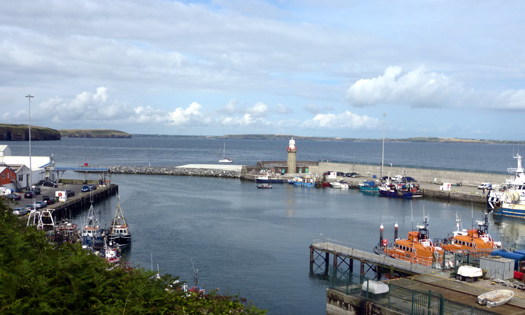
Dunmore East in mid-August. No sign of any dredging, and the "Visitors Pontoon" under the lighthouse on the East Pier is packed out with fishing boats.......Photo: W M Nixon
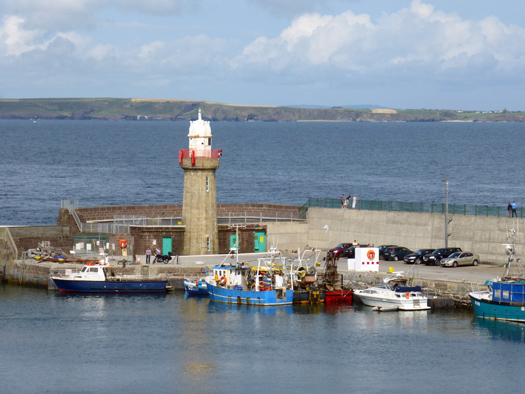
........and just one visiting German motor cruiser which was protected against any rafting up by its tender on the outer side. Photo: W M Nixon
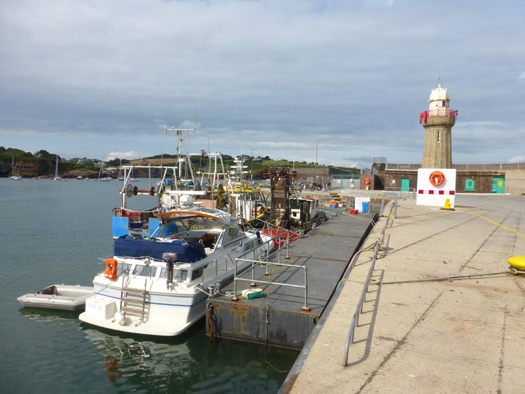
The new pontoon is an industrial standard piece of kit......Photo: W M Nixon
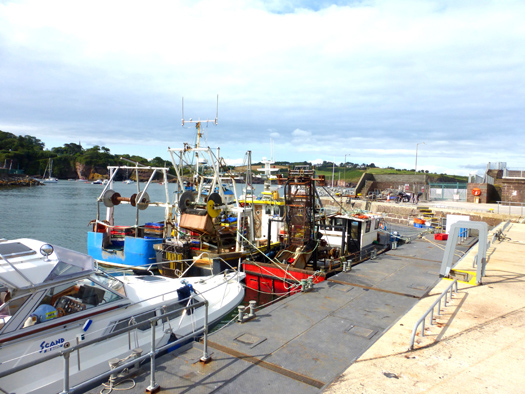
....and understandably very popular with active fishing boats. Photo: W M Nixon
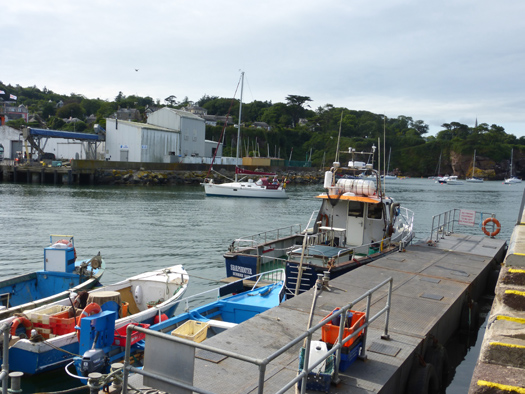
But for visiting sailing boats newly arrived in port.......Photo: W M Nixon
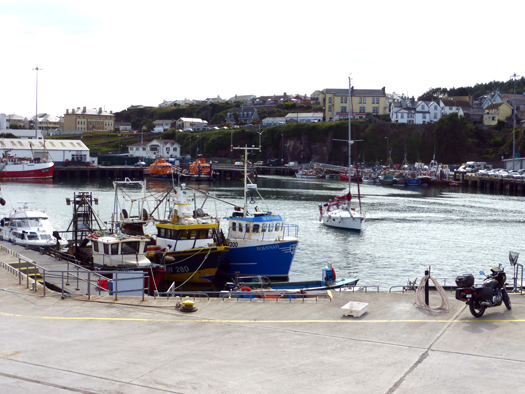
....it's soon clear that there isn't really a welcoming berth for them.....Photo: W M Nixon
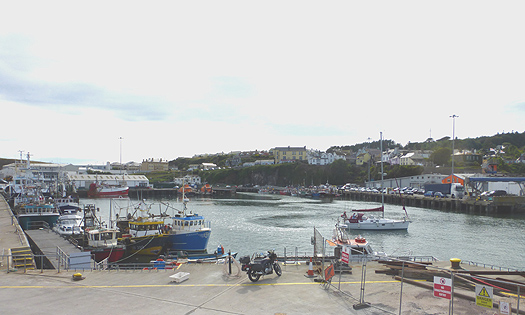
....and they head out to sea again, visibly disappointed by their Dunmore East welcome. Photo: W M Nixon
The Sailing & Boating Wonders of Ireland's West Cork Coast
The sailing paradise of West Cork on Ireland's south-west coast is at its best right now, and the south coast fleets are already heading that way for the traditional West Cork regattas in August. WM Nixon reflects on the magic sailing region of West Cork.
West Cork is as much of a frame of mind as a specific place. Officially, we might suppose it to extend all the way along the Rebel County's coast from the Old Head of Kinsale to Dursey Island away in the far nor'west, up at the north side of the wide entrance to Bantry Bay. But this doesn't necessarily mean that all the folk in the hinterland north of this coastline see themselves as being in West Cork.
As for boat people, our limits are much more narrowly defined. If you're afloat down there, West Cork is that sublime but compact bit of coastline between Galley Head and Mizen Head, just 38 miles as the gannet flies. It's the ultimate lotus land, with an interesting scattering of islands, blessed moreover with an abundance of sheltered natural harbours each with its own port town or village vying with its neighbours in colourful character. And visible from much of it is the Fastnet Rock, mysteriously a place of the remotest ocean despite being only a matter of four miles from the nearest land at Cape Clear.
In this magic land, the local mini-capital is of course Skibbereen, the very essence of a rural market town. But on the coast, the very different harbours of Schull, Baltimore, and sometimes even Glandore have been seen over the years as the sailors' capital of West Cork. Recently, however, it is Baltimore which has gone from strength to strength to affirm its position as the sailing capital of the southwest, and spending a June night there as summer settled comfortably over Munster reinforced the impression of its pre-eminence.
We were on a bit of a land cruise, so the bed for the night was in the Waterfront, the hotel where Room 12 is just about as near to the beating heart of Baltimore as you can get. Aboard a cruiser in Baltimore, you can enjoy that splendid isolation which a boat so easily confers. But in Room 12 on top of the Waterfront's northwest corner above the square, the busy life of the little port town bubbles about you, and the views across to Sherkin Island and over the country to Mount Gabriel get even more perfect with the approach of sunset.
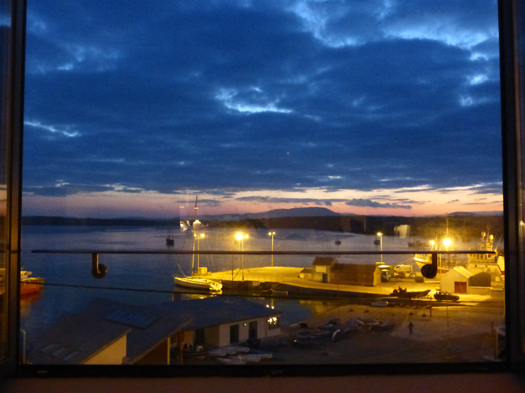
The view from Room 12 at the Waterfront in Baltimore. The sun has set beyond Mount Gabriel, but somebody is busy launching a newly-arrived RIB by floodlight, and the buzz from the square below is still rising. Photo: W M Nixon
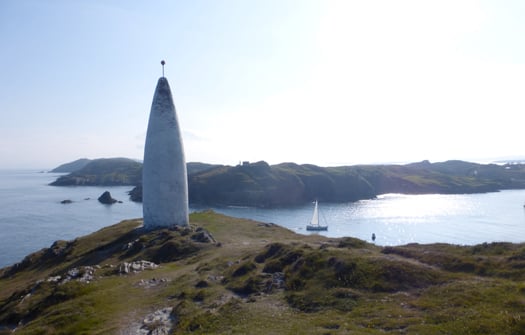
It has to be one of the best arrivals in world sailing. A cruiser enters Baltimore beneath the Baltimore Beacon, aka Lot's Wife. Photo: W M Nixon
It was fifty years ago when I first sailed in to Baltimore, coming in from the west on a round Ireland cruise, and entering port close under the beacon – Lot's Wife they call it – to find a quiet little place which showed some signs of a former prosperity, and hinted at better times to come. Back in 1964, it still had its railway station, but the West Cork Line was in its final year and was soon to be totally closed. Before that happened, later that summer when Baltimore Sailing Club hosted Dinghy Week for the Irish Dinghy Racing Association, the Firefly Class in Dun Laoghaire – mostly university boats – had been able to have a Tuesday night race. Then they'd towed their boats into Dun Laoghaire station on the launching trolleys, put them onto a CIE flat truck, and found them on Friday night safely delivered by rail the entire way to West Cork, offloaded ready at the harbourside station in Baltimore, and waiting for the arrival of thirsty crews keen for a bit of sport.
Mostly, they'd got themselves there by overloading some little car belonging to somebody or other's mother, so the fact that they disdained to use the railway themselves would help to explain why such a charming amenity was doomed. Since then, of course, Baltimore Railway Station from 1969 until recently had become Ireland's first Glenans base. But life moves on, the Glenans model doesn't seem to work any more in Ireland, so now the former station is for sale by the powers-that-be, and there are ructions being raised about it all which should keep everybody nicely exercised through the rest of the summer.
It was another French import which currently sets the pace in Baltimore. Around 1980 a young Breton fisherman, Youen Jacob, came into the harbour, and in time he settled there. To say that Youen Jacob has played a major role in Baltimore life is understating the case. It is he and his family who have developed the Waterfront – quite a challenge in somewhere as conservative as West Cork – and with Youen Jnr's Jolie Brise restaurant and guest house beside it to provide an alternative aspect of good Breton cuisine, the Jacob family's establishments have given a healthy new configuration to Baltimore's miniature harbourside square, and have settled in so well you could be forgiven for thinking the little town was built around them.
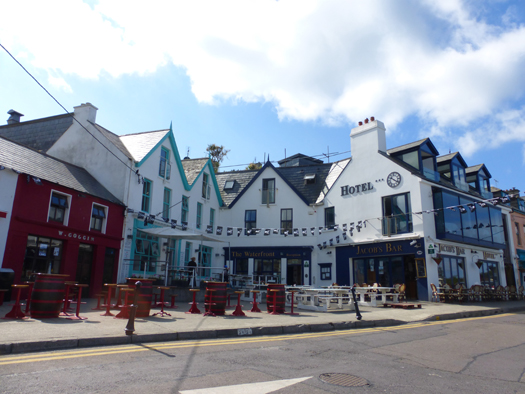
The Waterfront (right) and Jolie Brise at the south side of the mini-square in Baltimore bring a welcome breath of Brittany to West Cork. Photo: W M Nixon
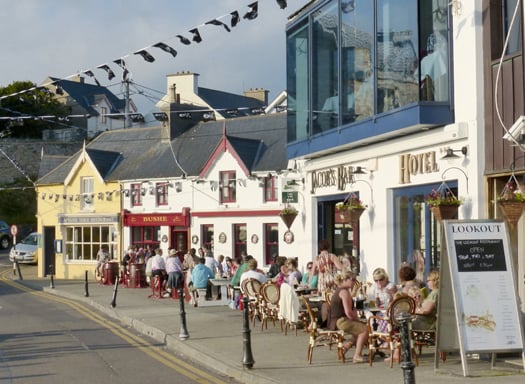
It's party time in Baltimore. The al fresco lifestyle is expected in West Cork in summer. Photo: W M Nixon
There are times when you'd understandably think this is the hub of the maritime universe, and why not? But if, during a quiet cruise, you think you might find it too hectic at night when the joint really is jumping, the sensible thing is to call by at lunchtime when everybody is out at the islands and Baltimore is refreshed and catching its breath for the next night's partying. Then in the evening, you can pop over to Sherkin Island where peace will reign while Baltimore ramps up the socializing.
Up in our eyrie above the square, we savoured the life of this busy little port. It's not quite a 24-hour town, but late at night boats were still being launched by floodlight, and conviviality continued in the square. Finally, peace descended, and though most folk were slow to stir early in the morning, the first ferries were coming in, and a workboat headed out for the islands, going past Graham Bailey's Peel Castle, the remarkable bisquine-rigged variation on a 50ft 1929-built Cornish lugger which is seen at her best on her mooring in Baltimore harbour. This is only right and proper, as the restoration and re-configuration of Peel Castle took place nearby, just up the Ilen River at one of the boatyards at Oldcourt.
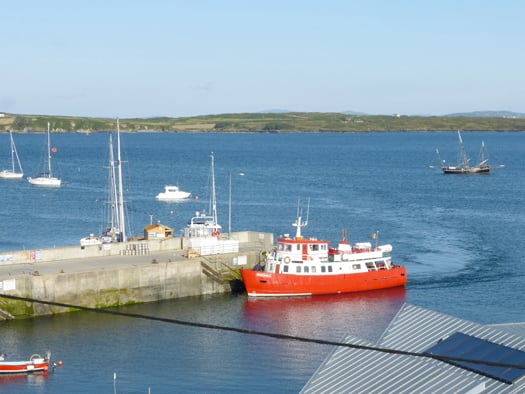
Good morning Baltimore, how are you? The first ferry arrives in from Sherkin Island. Photo: W M Nixon
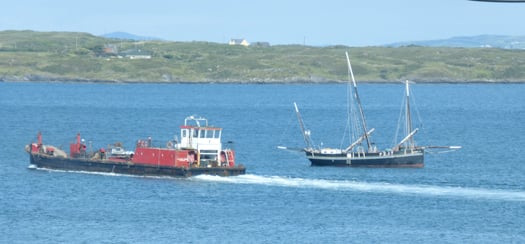
Getting the day's job started. A workboat heads out towards Sherkin past Graham Bailey's distinctive Peel Castle. Photo: W M Nixon
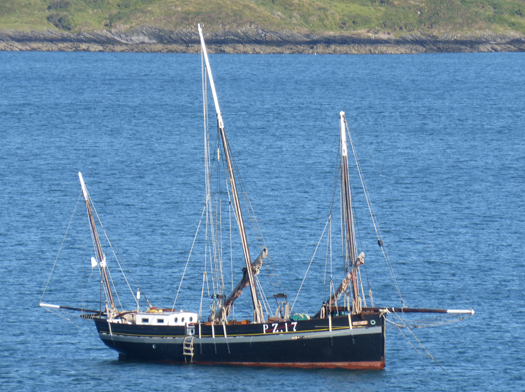
Peel Castle in all her glory in the middle of Baltimore Harbour. Restoring this 1929-built 50ft Cornish fishing boat and giving her a bisquine rig took Graham Bailey eight years of dedicated work at Oldcourt. Photo: W M Nixon
Another Baltimore revival which gets our approval is the restoration of the castle right in the middle of town, the "tigh mor" which presumably gives the place its name. We suffer from a widespread ruins overload in Ireland, so it's refreshing to find that somebody upped and took action, brining a ruin back to life and giving Baltimore a very effective signature focal point with a useful function. You could do the same to good effect at Dromineer on Lough Derg, where the ruined castle is an eyesore.
But you don't even have to leave the Baltimore area for a worthwhile restoration project, as just across the harbour beside the pier on Sherkin is the roofless ruin of the 15th Century Franciscan friary which we know looks much better with its roof back on, even if it has been missing since the 1770s.
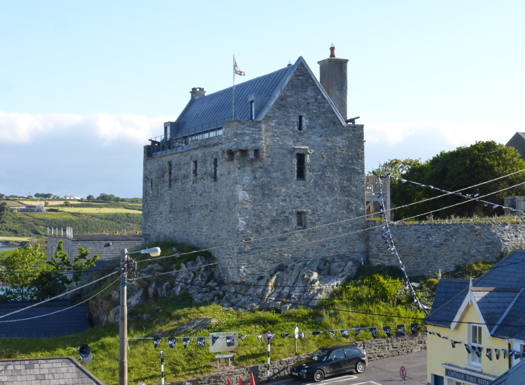
The restoration of the castle at Baltimore has given welcome and useful new life to a former ruin. Photo: W M Nixon
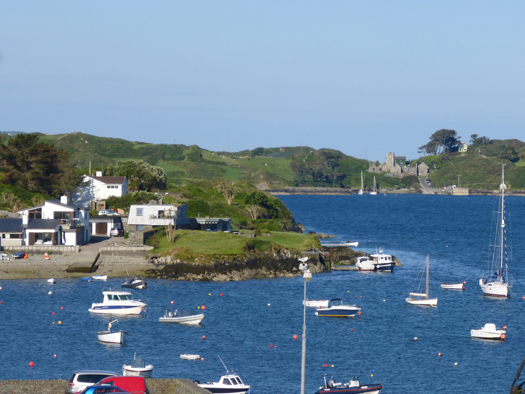
The Cove on the south side of Baltimore Harbour has some very desirable real estate. Photo: W M Nixon
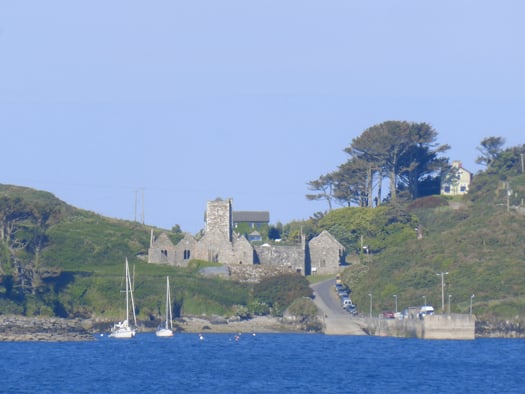
Thanks to its use as a film set in 1973, we know that the friary on Skerkin Island looks much better with it roof in place. Photo: W M Nixon
We know this because, in 1973, the makers of a TV film managed to get permission from the OPW to put a temporary but very convincing roof in place, and it looked so utterly right. The film was the unfairly forgotten Catholics, based on the novel of the same name by Belfast-born Brian Moore, and memorably starring Trevor Howard as the troubled Father Abbot. Even in this usually overlong blog, there isn't space to go into the details of the story, but it's worth viewing Catholics at the very least to see how well Sherkin friary looks with a roof. Alas, when filming was done the production company religiously (how else?) adhered to the OPW's demands to return the very attractive little old building to its ruinous state, and there it sadly sits.
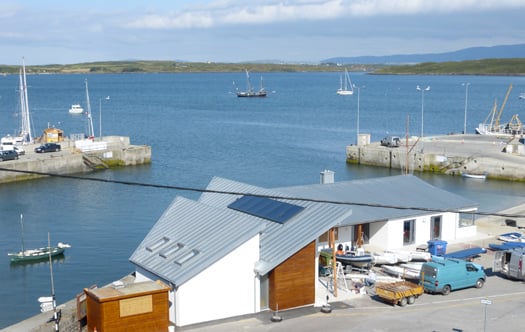
This year's work on Baltimore Sailing Club has made it even more of a local asset. Photo: W M Nixon
But as regular readers of Afloat.ie will know, other refurbishment and extension work has been under way in Baltimore, with the Sailing Club in fine fettle in its extended premises which look so well you'd think it's all new. It's certainly all of a piece with Baltimore's vitality, which contrasts with other little West Cork ports. In Baltimore, the key to it all is the fact that the Waterfront gallantly stays open all year round. But at present in Schull and Glandore, the main hotels don't even open in summer.
Doubtless in time, and sooner rather than later, both establishments will be brought back to life. But for people genuinely cruising, the absence of a hotel or two doesn't matter that much in an area where the abundance of cruising options and hospitable pubs with good food is almost bewildering. And around Baltimore in particular, there's always something going on.
The wholesome 1893-built cutter Eva (later known as Guillemot) was restored at Oldcourt, which is only a few miles from her birthplace 121 years ago on the Baltimore waterfront. Brian Marten's project to have Eva re-born and continue as Guillemot has come to a successful conclusion after she went through several vicissitudes before he happened upon her, but a visit to Oldcourt will reveal many other boat restoration, re-build and re-birth projects at various stages, including some which - as our accountancy friends would insist on putting it - are no longer going forward.
Be warned, however, that any visit to Oldcourt in any capacity whatever is likely to take longer than you expect, as there's simply so much to see. And they're at every stage, from projects just starting, through projects stalled, to projects nearing completion, while inspiration was being provided by a visiting boat, Darryl Hughes' immaculately-restored 1937 43ft Tyrrell ketch Maybird, which was berthed for a while at Oldcourt to let boatbuilder John Hegarty take off measurements in order to build a traditional clinker dinghy which will fit on board.
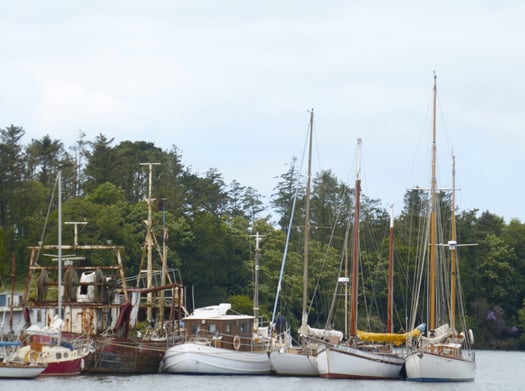
Boats in a row at Oldcourt. The further from the quay, the more ready for sea you are. Furthest out is the 1937 Tyrrell ketch Maybird, with which owner Darryl Hughes regularly attends the annual Yeats Summer School in Sligo. He's the only participant to arrive by sea, and he lives on board at the pontoon in Sligo during the Yeats festival. Photo: W M Nixon
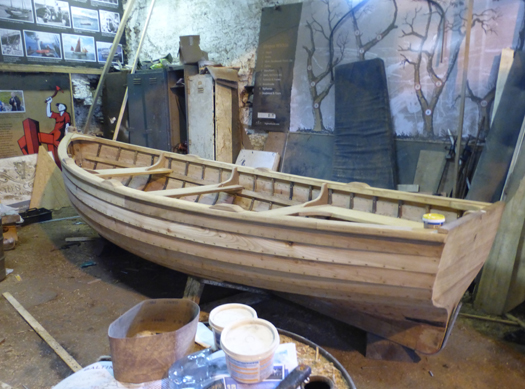
A new traditional clinker dinghy, built by John Hegarty of Oldcourt, awaits her first coast of varnish. Photo: W M Nixon
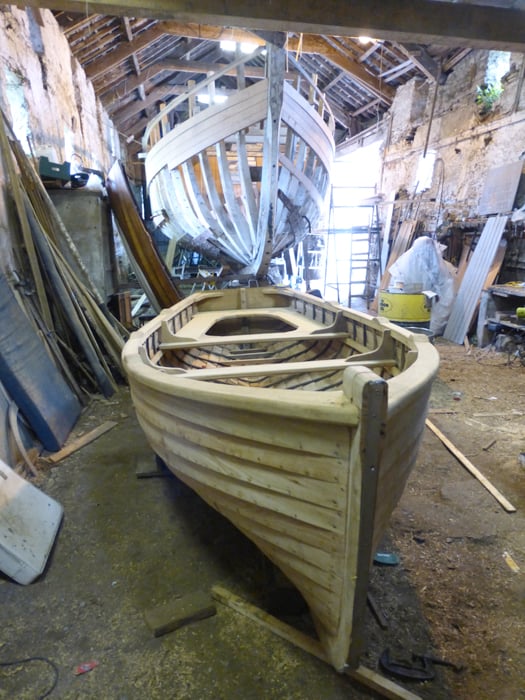
The new dinghy shares space with Conor O'Brien's Ilen, which continues to be a major work in progress. Photo: W M Nixon
Just to show what the result will be like, there was another recently-completed Hegarty dinghy in the Ilen shed, and very well it looked too. As for the restoration of Conor O'Brien's Ilen herself, that can best be described as ongoing. It has become such an absorbing task that the restoration process might best be thought of as an end in itself. Trying to work out what could most usefully be done with this hefty big lump of a boat if she ever is restored to seagoing condition is something which will require many brainstorming sessions, but it surely doesn't need to be considered in too much detail just yet.
The problem with the Ilen is she's too small for some things, and too big for others. She's of the same sort of in-between size which made the first Asgard of limited use as an official sail training vessel. Asgard was fine for teaching young people to sail, but she was simply too small to keep up with the tall ships which also completely overshadowed her in port, where Ireland's little ketch also failed to provide the necessary space and impressive setting for entertaining local bigwigs.
Manageability is the keynote to successful boat restorations. But Oldcourt is such a maritime universe that it can provide examples of what you'd think might have been eminently manageable restoration projects, yet they've ground to a halt. One such is Englyn, the creme de la crème of the boats amateur-designed by Harrison Butler, the English opthalmologist. In the 1930s, he was designing boats which successfully anticipated the highly-regarded designs of Lyle Hess more than forty years later, and the 26ft 6ins Englyn was so highly thought of by cruising guru Eric Hiscock that he included the design in his seminal book Cruising Under Sail, first published 1950.
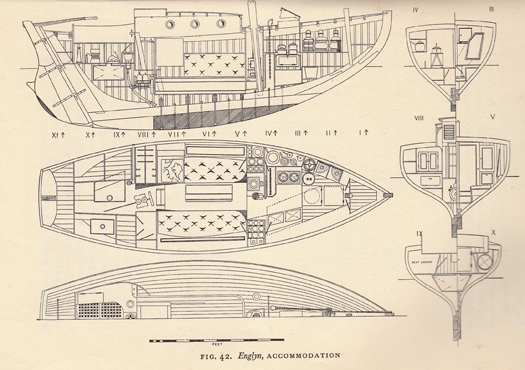
Plans of the Harrison Butler-designed Englyn, as featured in Eric Hiscock's Cruising Under Sail.
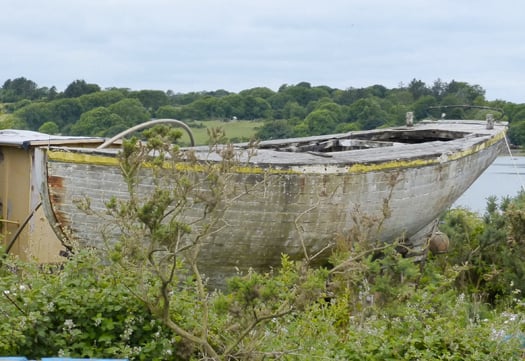
A little boat that may have missed the boat. Englyn as she is today. Photo: W M Nixon
If anything, the designs of Harrison Butler are more cherished than ever, and in this blog on May 10th we featured photos of the Harrison Butler Khamseen class cutter which ace boatbuilder Steve Morris is creating near Kilrush. It's heart-breaking to see the lines of Steve's healthy boat palely reflected in the weather-beaten remains of Englyn as she is today. But sometimes boats really can be brought back from the near-dead, and at the two-day Glandore Classic Boat Summer School in mid-July, the entire Sunday afternoon was given over to presentations about boats in various stages of restoration in and around Oldcourt.
Despite some unpleasantnesses visited upon it by the lingering death of the Celtic Tiger, Glandore gallantly soldiers on. Glandore Harbour Yacht Club's new headquarters in a cleverly rebuilt two-storey cottage up a side street (the only side street, as it happens) is appropriate to the good taste which prevails in this sweet place, whose name in Irish can mean either the golden harbour, or the harbour of the oaks - either will do very nicely.
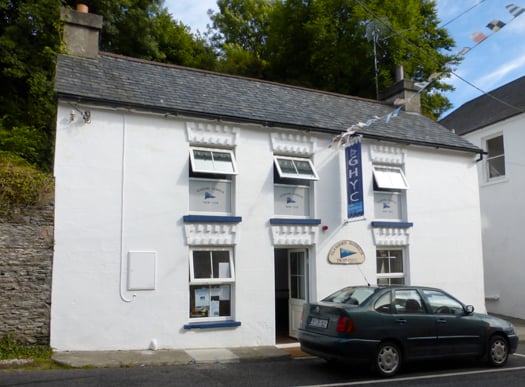
Glandore Harbour YC's clubhouse is now this cleverly re-built two-storey cottage beside the harbour. Photo: W M Nixon
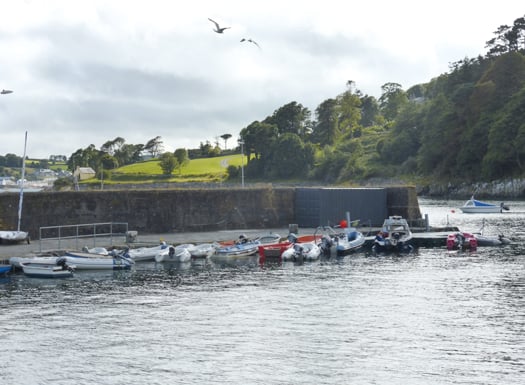
The outboard dinghies waiting at the pontoon at Glandore Pier give a good indication of the number of boats based in Glandore and across the harbour at Union Hall. Photo: W M Nixon
The Summer School packed in an extraordinary variety of topics, and even this blogger was wheeled out to develop his thesis based around the ambiguous question: Why shouldn't the Irish be a seafaring people? Don't worry, for those who missed it, we'll push it out again here some time in the depth of winter. But we cannot hope to convey the full wonder of the best event in the Summer School, the question-and-answer session between ocean voyaging and offshore racing legend Don Street and his son Richard.
The old boy hasn't half been around. And if at some time your only experience of Don Street has been a high-pitched New England rant about some iniquity of modern yachting (fibreglass dismissed as "frozen snot", for instance) it's my happy duty to assure you that, as he delved into his extraordinary memories, the pitch of Don Street's distinctive voice became deeper and more resonant, until by the time he concluded all too early, we could have been listening to Captain Ahab himself.
From such a treasure trove of recollection, there were many gems, perhaps the best being about how he came to make his profession in writing about the sea and sailing. In his early days in the Caribbean before he'd put pen to paper, on one run ashore Don and his shipmates met up with Nobel Laureate John Steinbeck, and they'd a convivial time together. Later, heading back along the islands, they'd another dinner with the great writer, and during yarning at table, Don's shipmates insisted he'd so many good stories to tell that he should write them down.
"But I don't know how to spell, and I know nothing about grammar" complained Don.
"But you've a story to tell" said Steinbeck, "and you tell it well. Just you write it down, and the editors will sort out the spelling and the punctuation and the grammar. That's their job."
God be with the days......
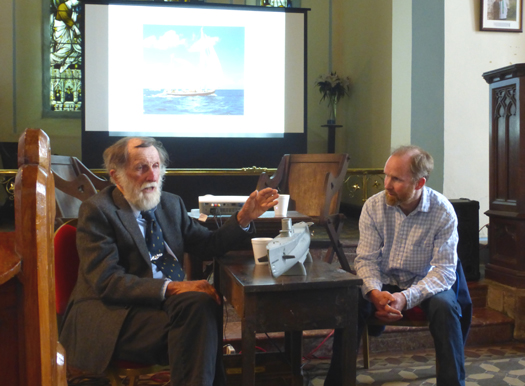
The old man of the sea – Don Street's reminiscences were the highlight of this year's Glandore Classic Boat Summer School. The school sessions were held in the harbourside church, and Don is seen here with his son Richard while he recalls his days in submarines in the US Navy. On the screen is his legendary 1905-built yawl Iolaire, in which he cruised the Caribbean and crossed the Atlantic. Photo: W M Nixon
#ROWING: Holly Nixon of Portora was in the number two seat of the composite crew which finished second in the final of the Princess Grace for women’s quadruple sculls at Henley Royal Regatta. The race was won Leander and Gloucester, a senior British women’s quadruple, with Gloucester and Northwich, an under-23 British composite crew, three and a quarter lengths behind them at the finish. Nixon wore her Portora colours, but under Henley rules only two club names are listed for composite crews.
Henley Royal Regatta
Princess Grace (Women’s Quadruple, Open): Leander and Gloucester bt Gloucester and Northwich 3¼l, 7 mins 31 secs.
Nixon Gives Portora Boost at Henley Women's Rowing
#ROWING: Holly Nixon brought Portora a title at Henley Women’s Regatta today. The Enniskillen woman teamed up with Lucy Burgess, Mathilda Hodgkins-Byrne and Josephine Wratten to take the Borne Cup for elite quadruple sculls with a six-length win in the final over a French composite. In the junior coxed four, Portora had given way to Henley Rowing Club (the eventual winners) and in the junior 16 coxed four American crew St Paul’s had beaten them at the quarter-final stage.
Women’s Henley (Finals; Irish interest):
Elite Quadruple Sculls: Gloucester H/Northwich/Tees/Portora bt Grenoble/Caen, D’Avignon 6l.
Trunk and Arms Single Sculls: Tribesmen (K O’Brien) bt Cantabrigian (C Connon) 3l.
#dunmoreeast – The Minister for Agriculture, Food and the Marine, Simon Coveney TD, today announced details of a €4m dredging project at Dunmore East Fishery Harbour Centre on the occasion of the official opening of a €450,000 renovation of the Marine Leisure Area at the western end of the harbour.
At the opening, the Minister said "I am delighted to officially open this. The completion of this project adds greatly to the Harbour for marine activities generally. This end of the Harbour was in need of revamping for some time, and I prioritised works to make it a fit for purpose amenity which will benefit and promote the marine leisure industry in this area".
Leisure activity in Dunmore East has been increasing substantially in recent years with 180 visiting yachts from all over Ireland and abroad using the harbour in 2013, more than a threefold increase on previous years. Cruise line passengers nearly doubled in 2013 to 9,500 and with the newly renovated slipway it is expected that usage by members of the public will double in 2014 from around 600 in 2013.
The €450,000 renovation included extending the existing slipway, widening it from five to twelve metres, resurfacing and generally improving vehicle and pedestrian access, the development of a promenade with street lighting, improved access to the beach, and a rock armour embankment to protect the development from severe weather conditions.
Commenting on the works the Minister said "This is an excellent piece of infrastructure and is now a top class amenity which will lend itself to the further development of the leisure industry in Dunmore East, and the spin off that will have for tourism and jobs locally".
Announcing the €4m dredging project for Dunmore East to resolve the impacts of years of siltation in the harbour, which has restricted vessel traffic and made manoeuvrability and fish landings problematic for fishermen the Minister said "This significant investment in Dunmore East from the 2014 Fishery Harbour Capital Programme is an indication of this Government's commitment to the fishing industry in the South East. When complete, not only will the harbour be more accessible to larger vessels, landing times and management will be much improved as will the usability of the syncrolift".
Latest figures indicate that the value and volume of fish landings in Dunmore East has been on the increase for a number of years. Between 2010 and 2013 landings increased by 40% from 8,387 tonnes to an estimated 11,718 tonnes. The equivalent value of these landings went from €13.7m in 2010 to an estimated €17.5m in 2013 an increase of 28%.
The Minister went on to say "Taking account of the increased level of fish landings I am conscious of the need to dovetail the much needed dredging works with the seasonal work patterns of the fishing industry to cause as little disruption as possible. With that in mind every effort will be made to ensure that the works will be completed in advance of the important herring fishery later in the year".
Groundwork for the project is well advanced; a public procurement exercise will be initiated in May, with a view to awarding the contract in time for an August commencement date.
Concluding the Minister said "The development and upkeep of Dunmore East as a state of the art Fishery Harbour Centre, supporting a broad range of marine related activities is and will remain an ongoing process. These two major projects and the recent installation of floating pontoons within the Harbour are part of a long term strategy to deliver on the potential of Dunmore East for job creation for the fishing industry and as a marine leisure and tourist destination".
Holly Nixon is Afloat Rower of the Year 2011
#ROWING – Holly Nixon is the Afloat Rower of the Year for 2011. The Enniskillen woman won the Afloat Rower of the Month award for August after making history by becoming the first Ireland rower to medal at the World Junior Championships. Nixon took silver in the single sculls behind Anne Beenken of Germany at Dorney Lake, the site of next year’s Olympic Games regatta. In June she had joined up with Sanita Puspure, Lisa Dilleen and Eimear Moran to win the elite quadruple sculls at Henley Women’s Regatta.
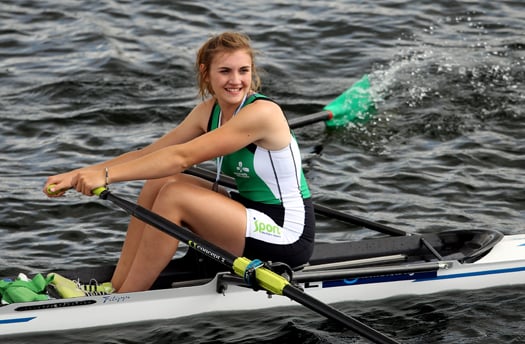
Ireland's Holly Nixon pictured after winning Silver in the Women's Single Sculls at the 2011 World Rowing Junior Championships at Dorney Lake in August. Photo: Scott Heavey/Getty Images
The Devenish College student and Portora rower is now concentrating on her A Levels, but her performances at the recent National Assessment and approaches from American universities with scholarship offers suggests that she has a bright future as a rower.
Rower of the Year: The judging panel is made up of Liam Gorman, rowing correspondent of The Irish Times, President of Rowing Ireland Anthony Dooley and David O'Brien, Editor of Afloat magazine. Monthly awards for achievements during the year appear on afloat.ie. Keep an eye for the Rower of the Month awards in 2012.
Nixon Leaves Junior Rowing Ranks With a Win
Holly Nixon, the World Championship silver medallist in single sculling at junior level, competed for the last time in this class as she turns 18 next month. She was the fastest woman – and the joint 15th fastest sculler overall.
Neptune Head of the River, Blessington, Saturday (selected results)
Overall: 1 Castleconnell/Garda/University of Limerick senior eight (head two) 11 minutes 49 seconds, 2 UCD sen eight (head two) 11:51, 3 Castleconnell/UL sen eight (head one) 11:54, 4 Trinity intermediate eight (head one) 12:12, 5 UCD inter eight (head one) 12:28, 6 Neptune junior 18 eight (head two) 12:35.
Men
Eight – Senior: 1 Castleconnell/Garda/University of Limerick (hd 2) 11:49, 2 UCD (hd 2) 11:51, 3 Castleconell/University of Limerick (hd 1) 11:54. Intermediate: 1 Trinity (hd 1) 12:12, 2 UCD (hd 1) 12:28, 3 Commercial (hd 2) 12:46. Novice: 1 UCD (hd 1) 12:40, 2 Trinity (hd 1) 12:47, 3 Trinity (hd 2) 13:29. Junior 18: 1 Neptune (hd 2) 12:35, 2 Portora (hd 2) 13:57, 3 Castleconnell (hd 1) 14:03. Junior 16: 1 Neptune (hd 1) 12:53, 2 Col Chiarain 15:03, 3 Neptune (hd 2) 15:10. Masters: Commercial 12:40.
Four – Senior: 1 UCD (hd 1) 12:43, 2 Garda/University of Limerick (hd 1) 12:49, 3 St Michael’s 13:17. Intermediate: 1 St Michael’s (hd 1) 13:23, 2 Commercial (hd 1) 13:46, 3 Trinity (hd 2) 13:50. Junior 18: Castleconnell 14:15.
Sculling, Double – Senior: 1 Commercial (W Yeomans, C O Riada; hd 1) 13:24, 2 St Michael’s (hd 1) 13:47, 3 Clonmel (hd 2) 14:07.
Single - Senior: 1 Carlow (K Coughlan, hd 1) 15:22, 2 Carlow (Coughlan, hd 2) 15:40, 3 Portora (Murphy, hd 1) 15:48.
Intermediate: 1 Neptune (Bailey, head one) 14:33, 2 St Michael’s (O’Brien) 14:55, 3 Neptune (Bailey, head two) 14:56. Junior 18: 1 Neptune (Griffin, hd 1) 14:50, 2 Portora (Seaman, hd 1) 15:01, 3 Castleconnell (Quinlan, hd 1) 15:14.
Women
Eight – Senior: Trinity (hd 1) 13:33, 2 Trinity (hd 2) 13:50, 3 Offaly/Old Collegians/Three Castles (quadruple; hd 2) 14:36. Intermediate: 1 Commercial (hd 1) 14:38, 2 Garda (hd 1) 16:01, 3 Garda (hd 2) 16:30. Novice: 1 Trinity (hd 1) 15:00, 2 Trinity (hd 2) 16:02, 3 Neptune (hd 2) 16:11. Junior 18: 1 Neptune (hd 1) 14:10, 2 Shannon (hd 1) 14:32, 3 Portora (hd 1) 14:40. Junior 16: 1 Commercial (hd 2) 15:56, 2 Commercial (hd 1) 16:02, 3 Col Chiarain (hd 1) 17:50.
Four – Senior: Trinity 16:33. Novice: Trinity 17:22.
Sculling, Double – Senior: 1 Portora (H Nixon, K Cromie; hd 2) 14:55, 2 St Michael’s (hd 2) 15:22, 3 St Michael’s C (hd 2) 15:53.
Single – Senior (all Head One): 1 Three Castles (Moran) 15:34, 2 St Michael’s (Clavin) 15:59, 3 Old Collegians (Walshe) 16:04.
Intermediate (all Head One): 1 Trinity (Dolan) 16:03, 2 Shandon (Corcoran-O’Hare) 16:26, 3 St Michael’s (Leahy) 16:34. Junior 18: 1 Portora (H Nixon, hd 1) 15:21, 2 Portora (Cromie, hd 1) 16:35, 3 Neptune (O’Brien, hd 2) 16:56.
Nixon's Silver Makes Her Afloat Rower of the Month
Rower of the Month awards: The judging panel is made up of Liam Gorman, rowing correspondent of The Irish Times, President of Rowing Ireland Anthony Dooley and David O'Brien, Editor of Afloat magazine. Monthly awards for achievements during the year will appear on afloat.ie and the overall national award will be presented to the person or crew who, in the judges' opinion, achieved the most notable results in, or made the most significant contribution to rowing during 2011. Keep a monthly eye on progress and watch our 2011 champions list grow.




























